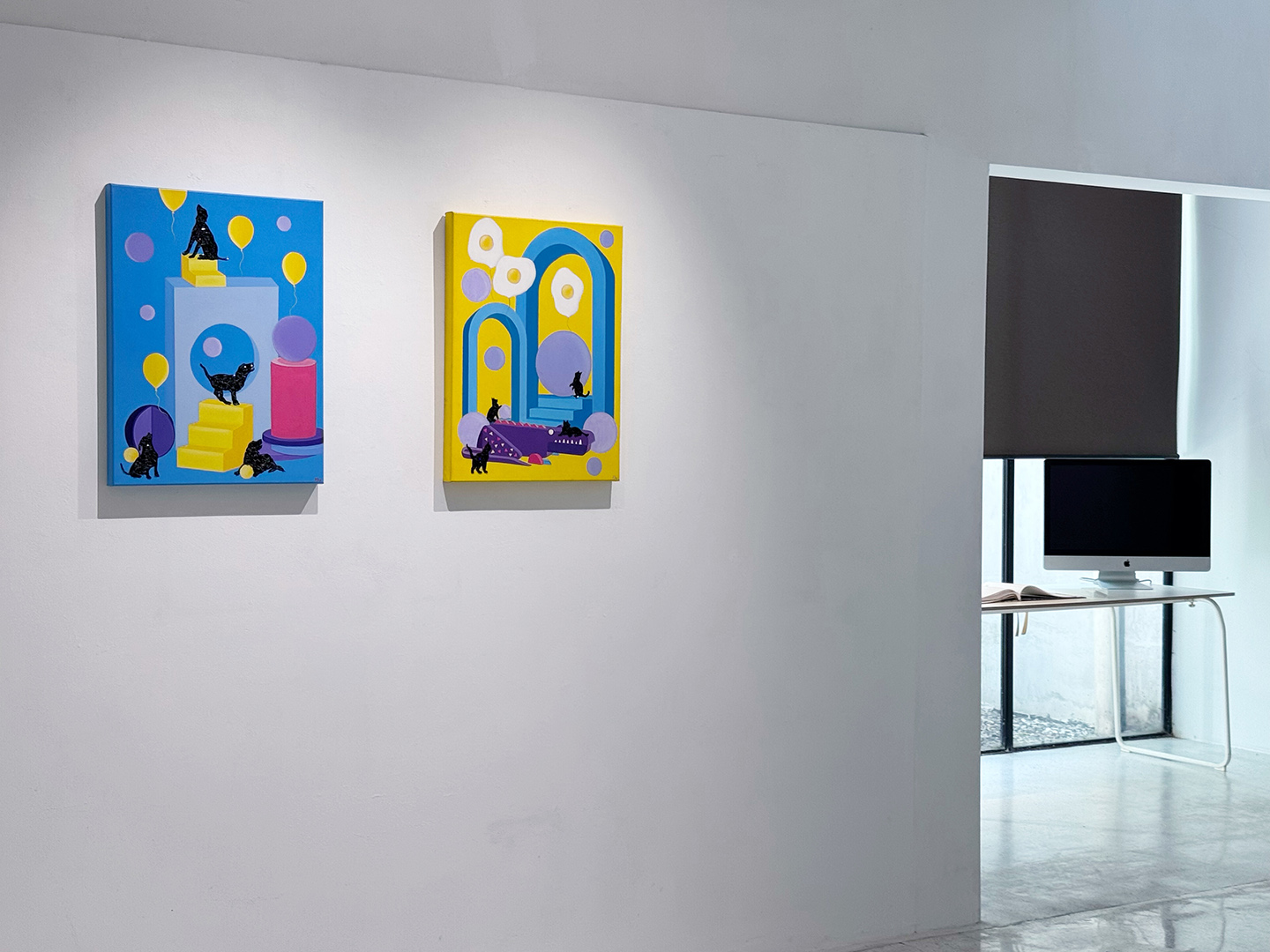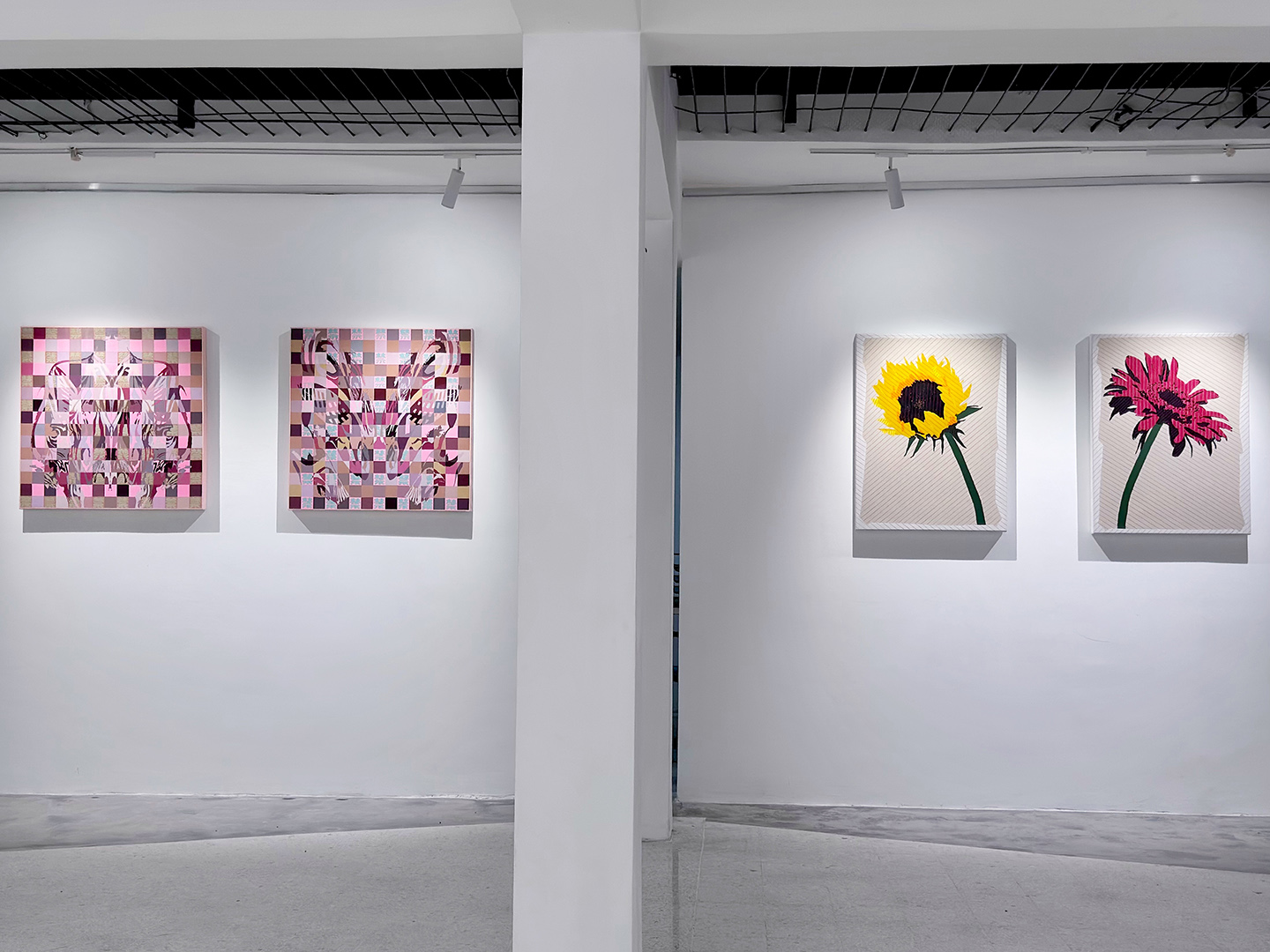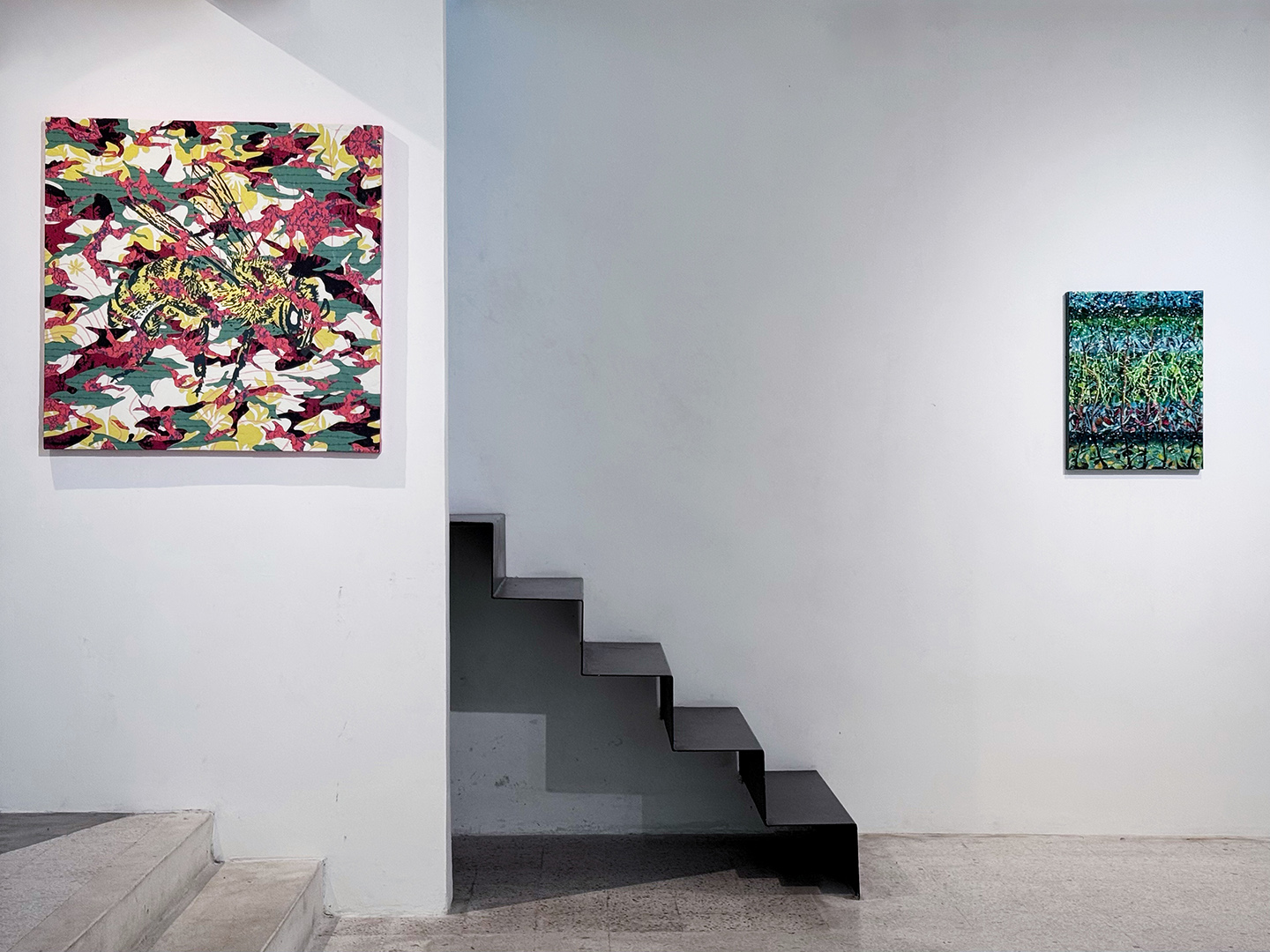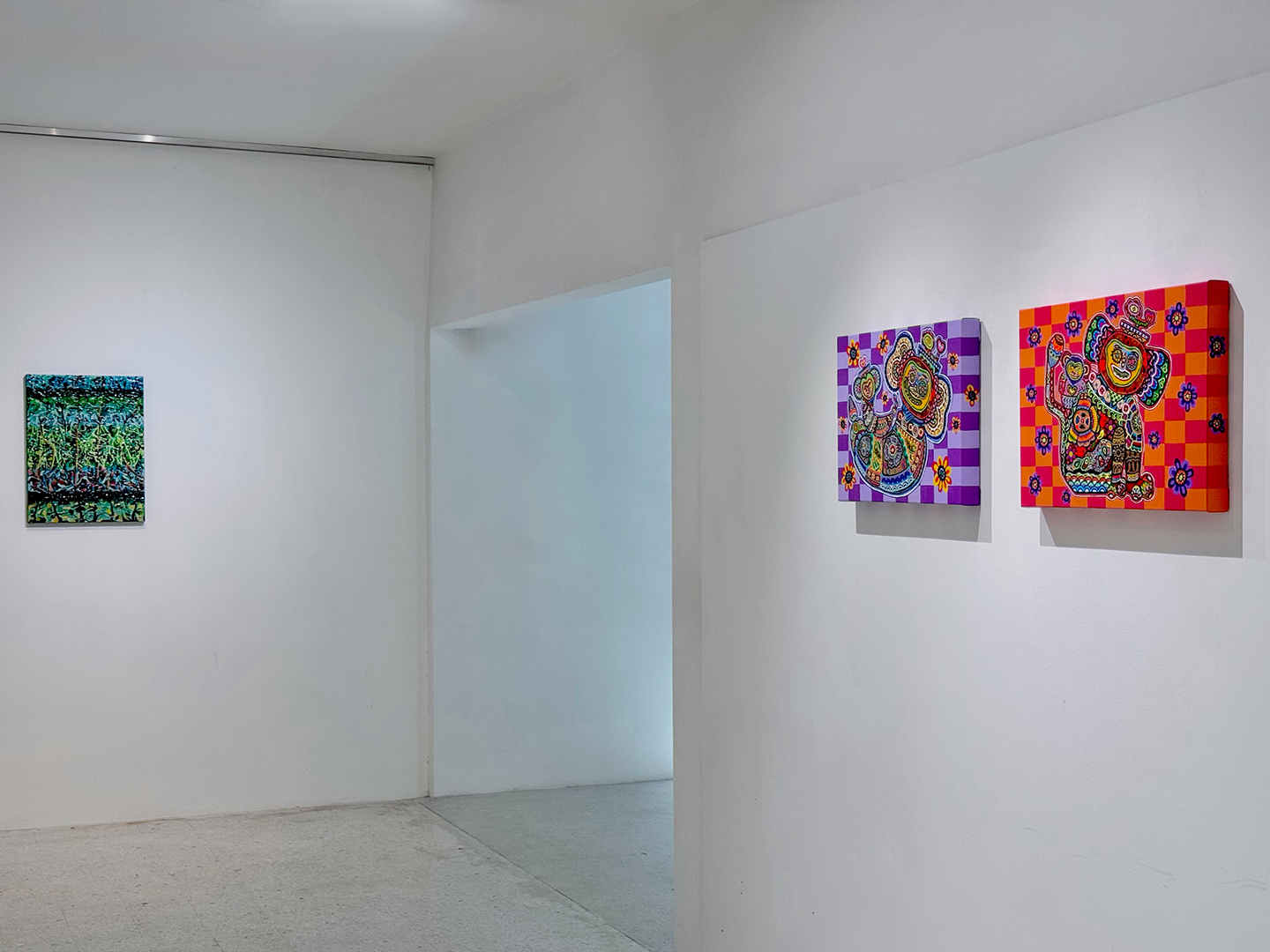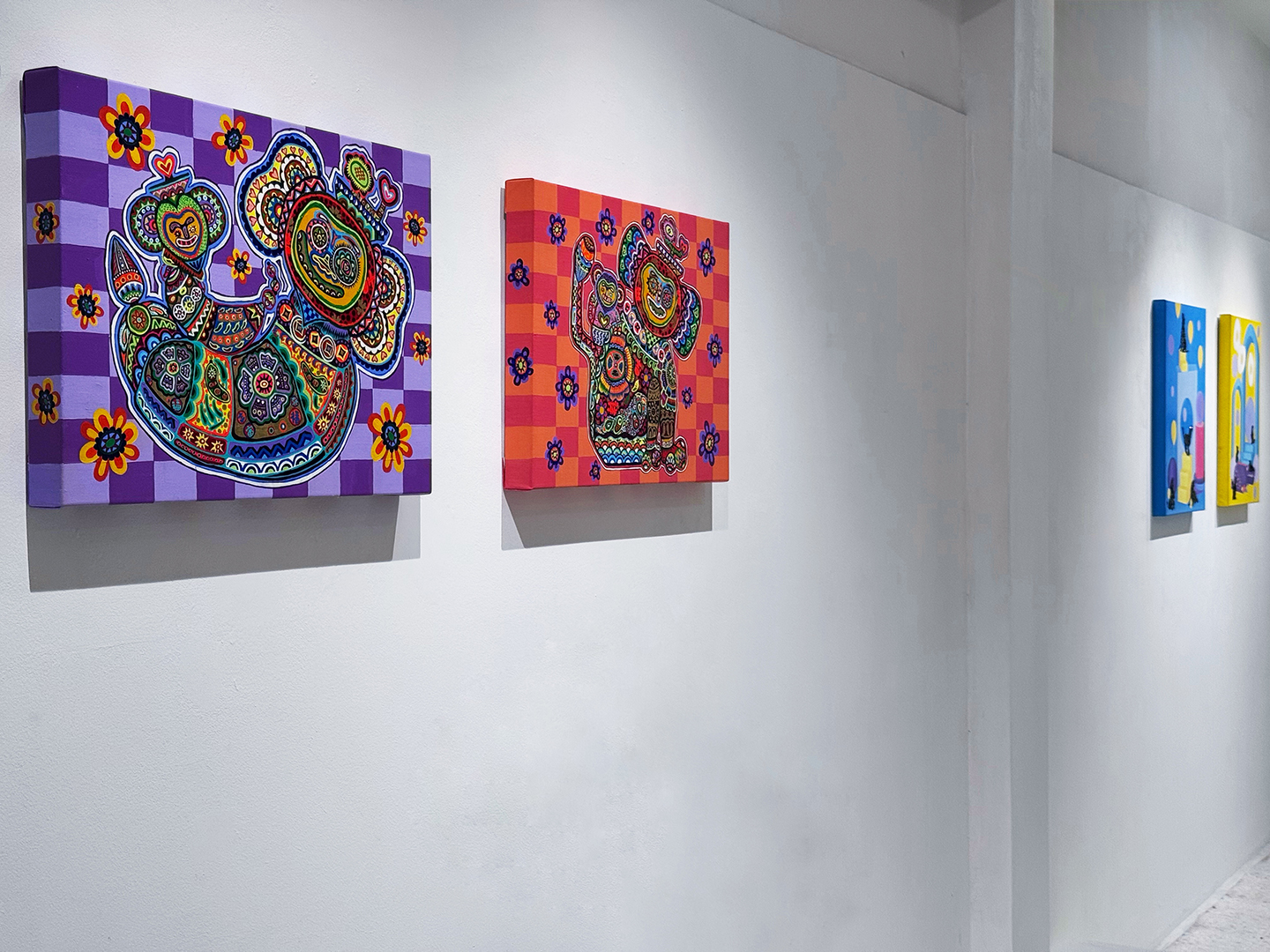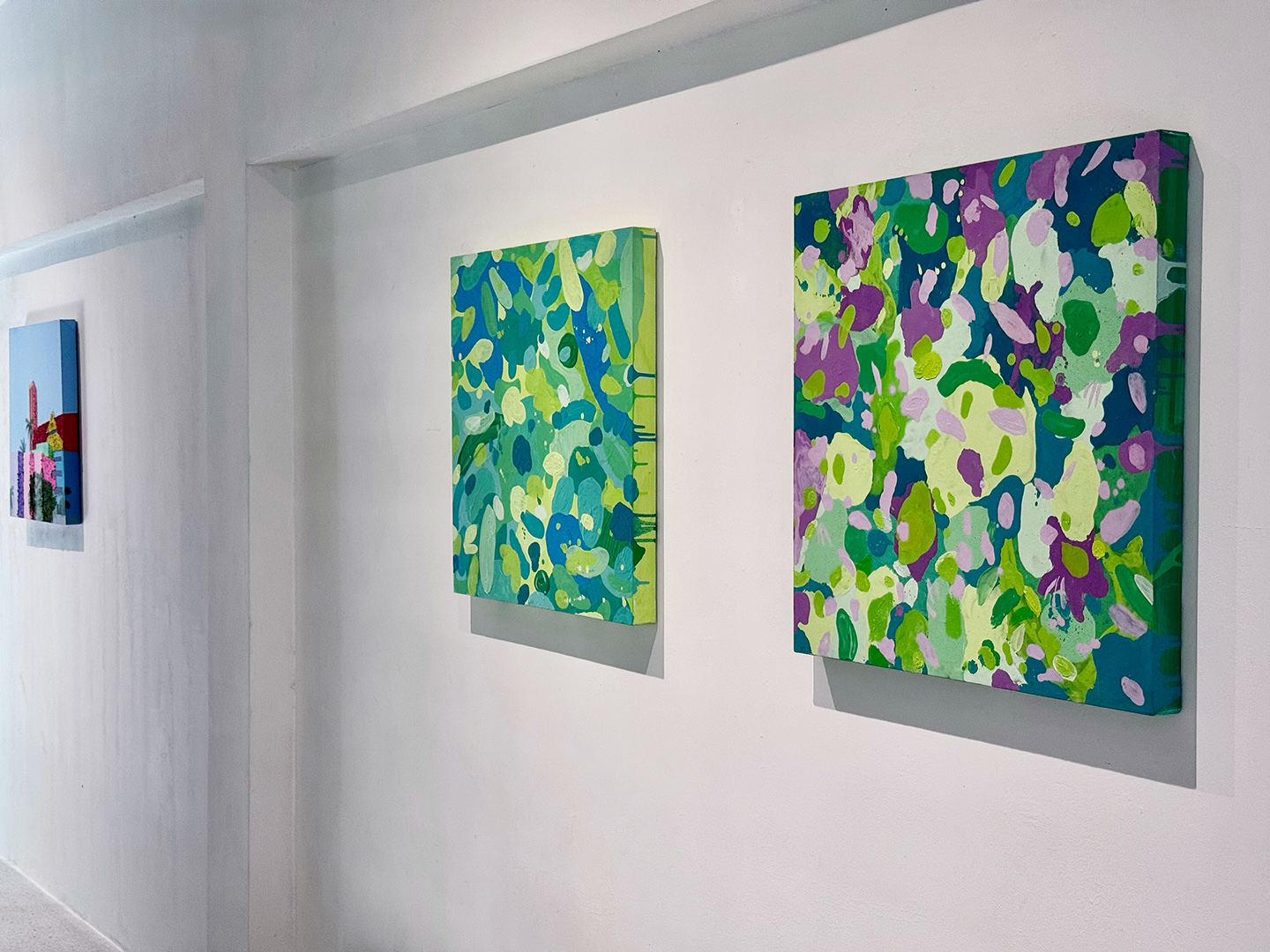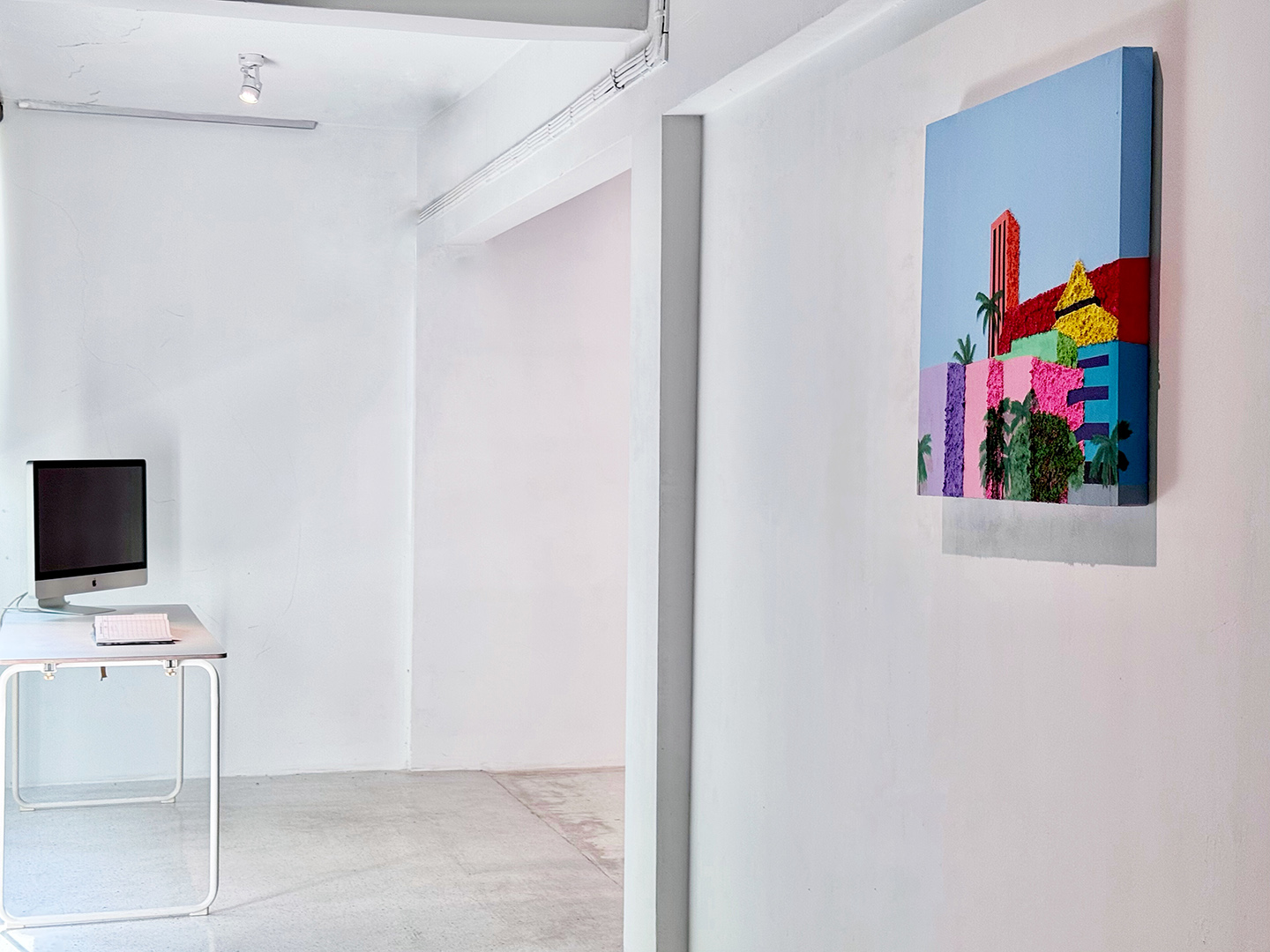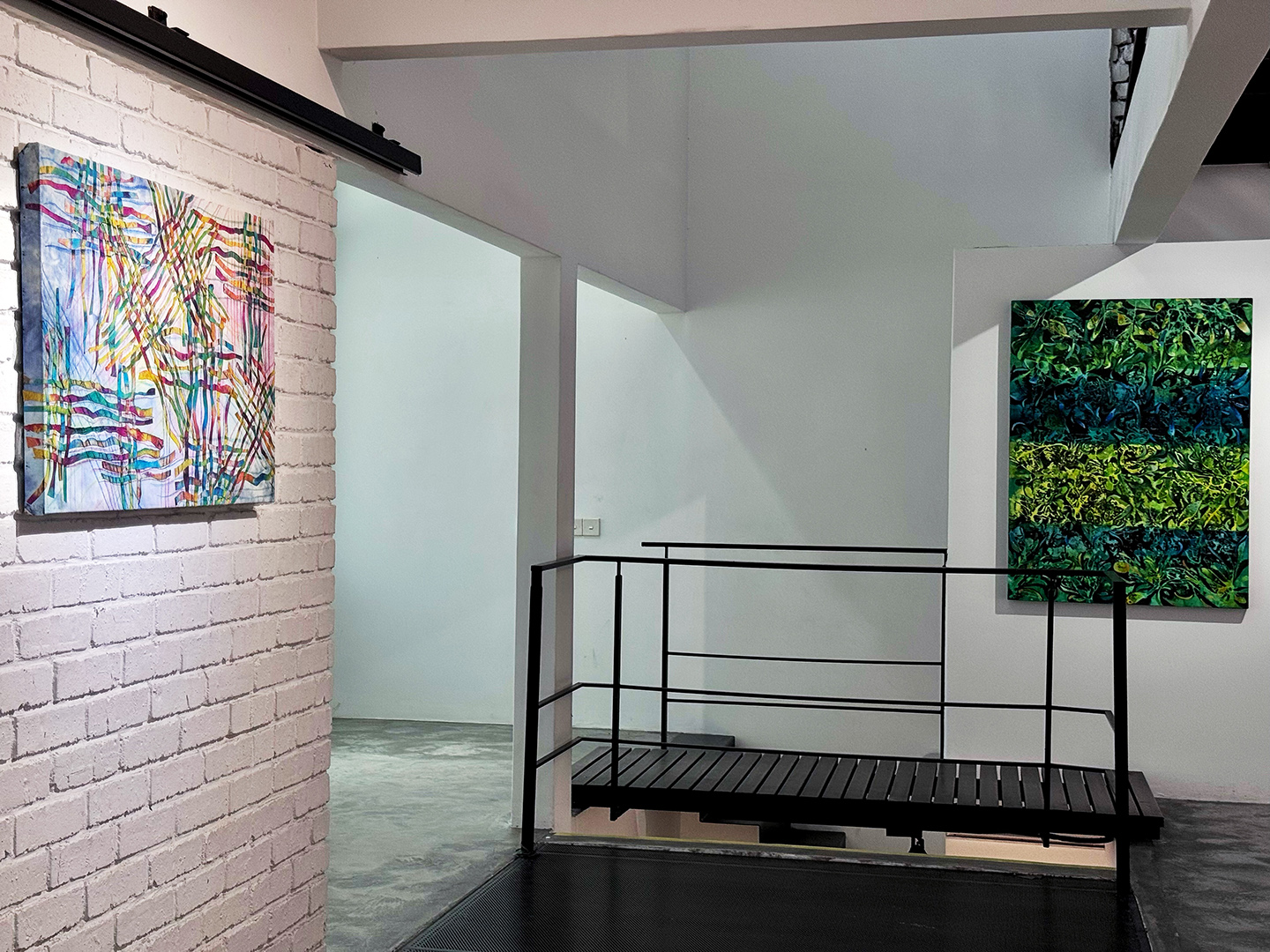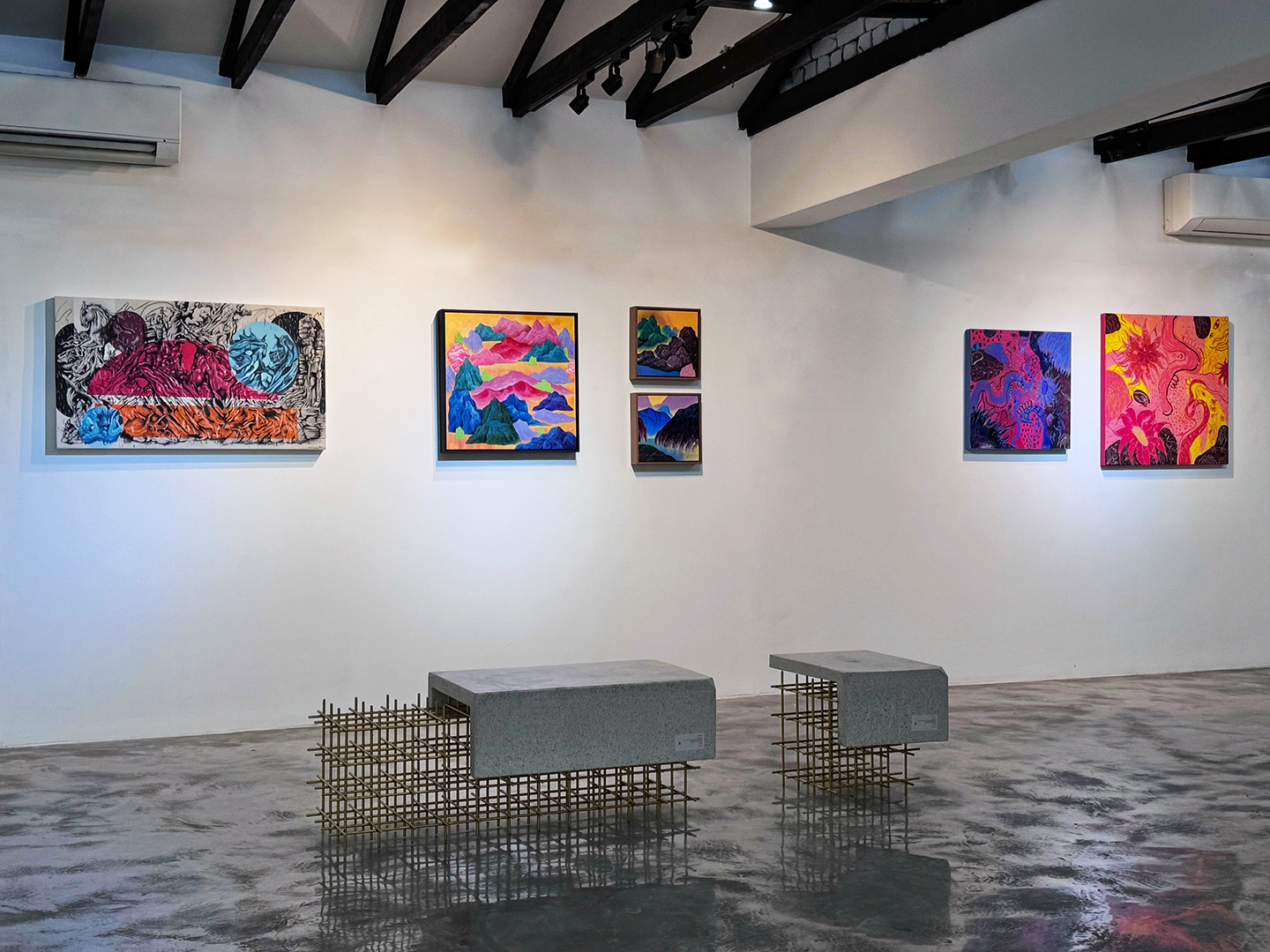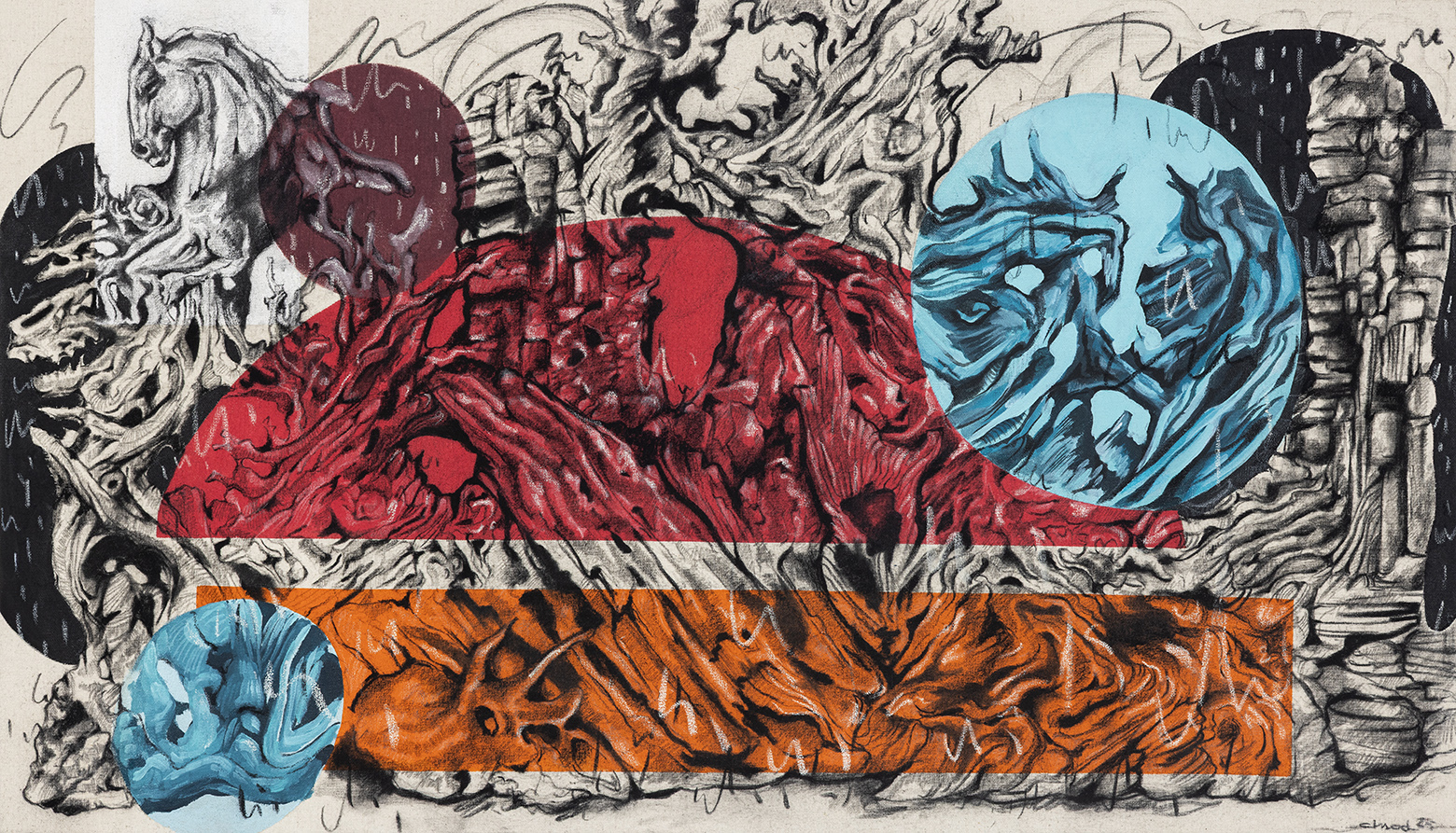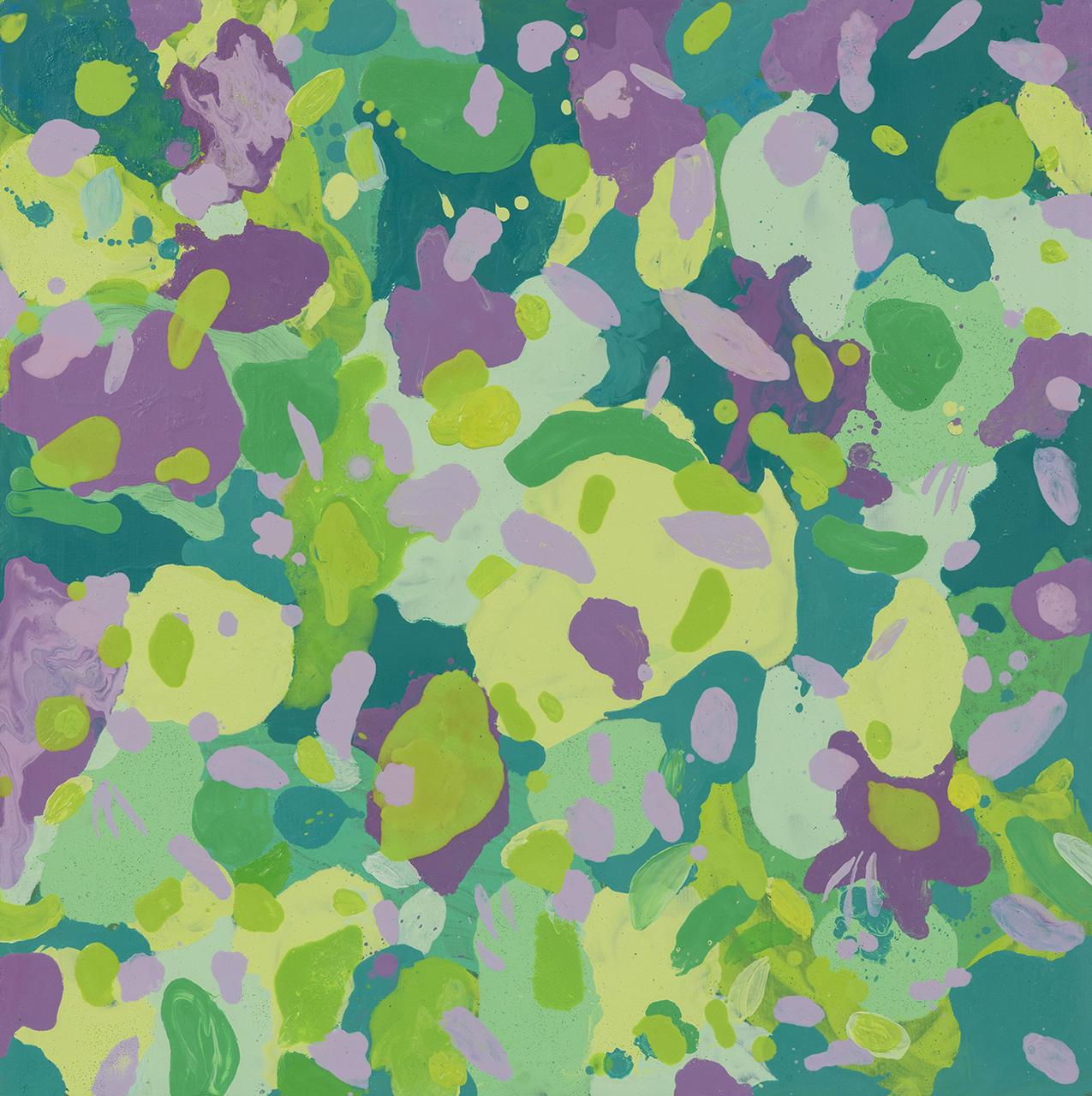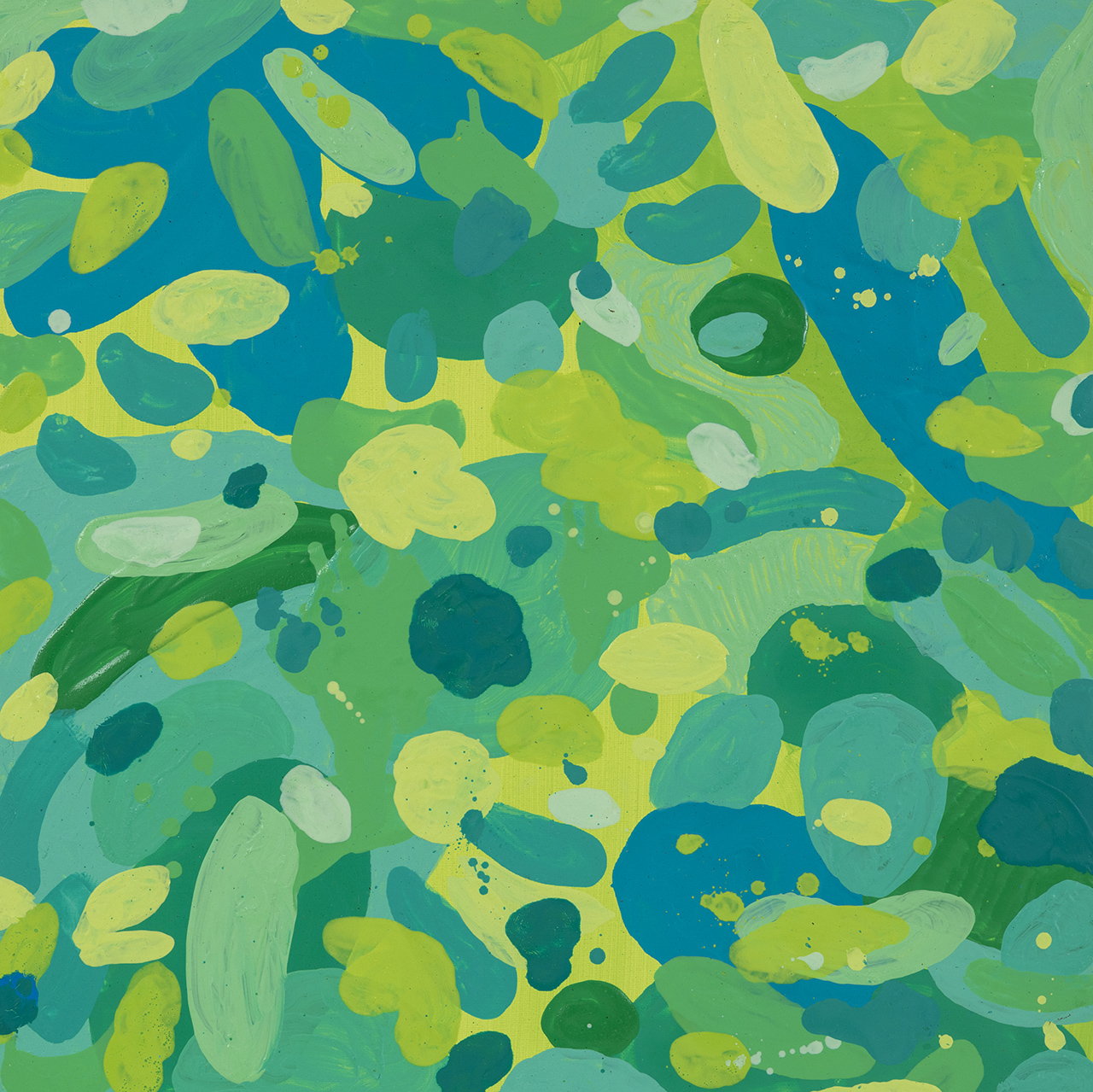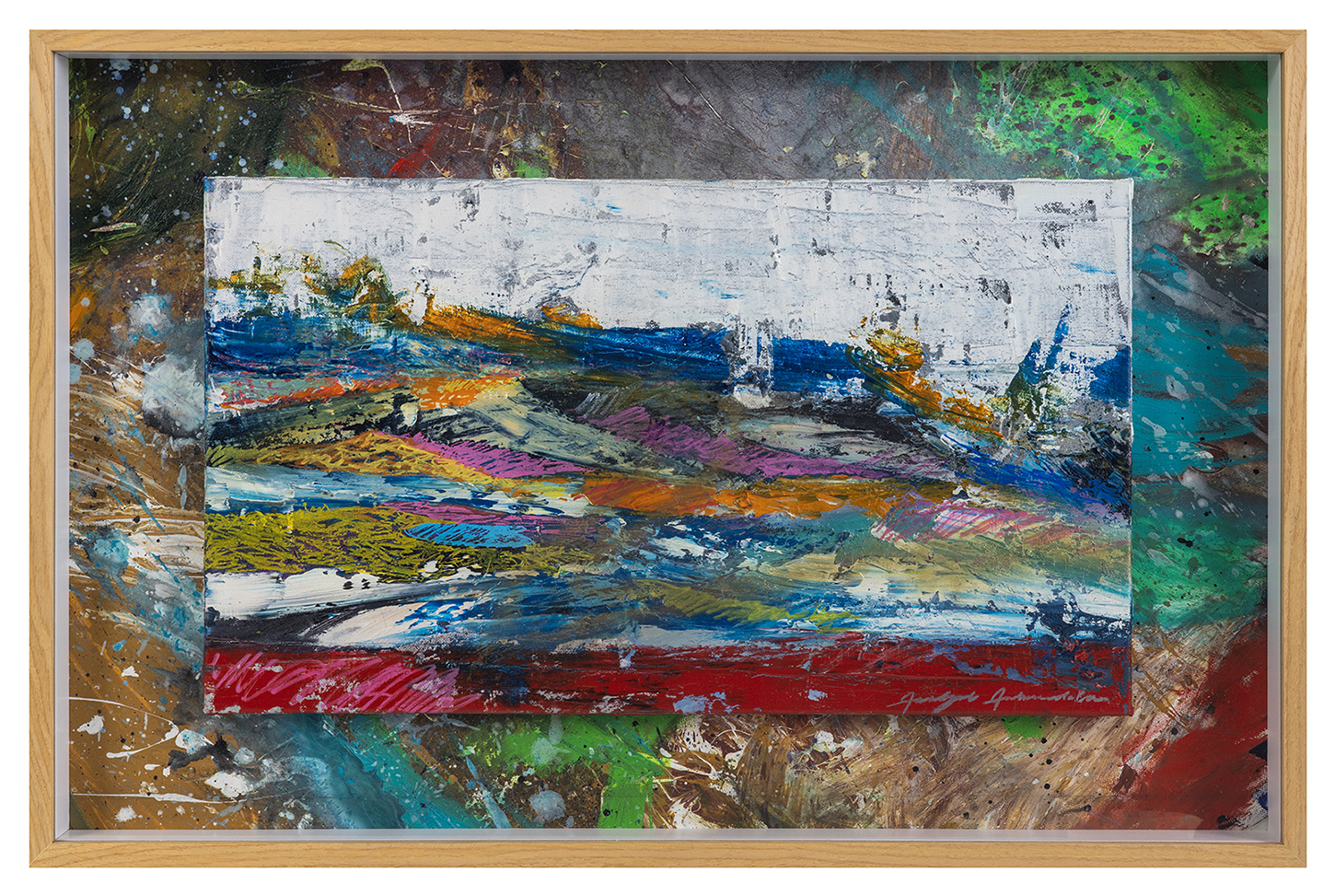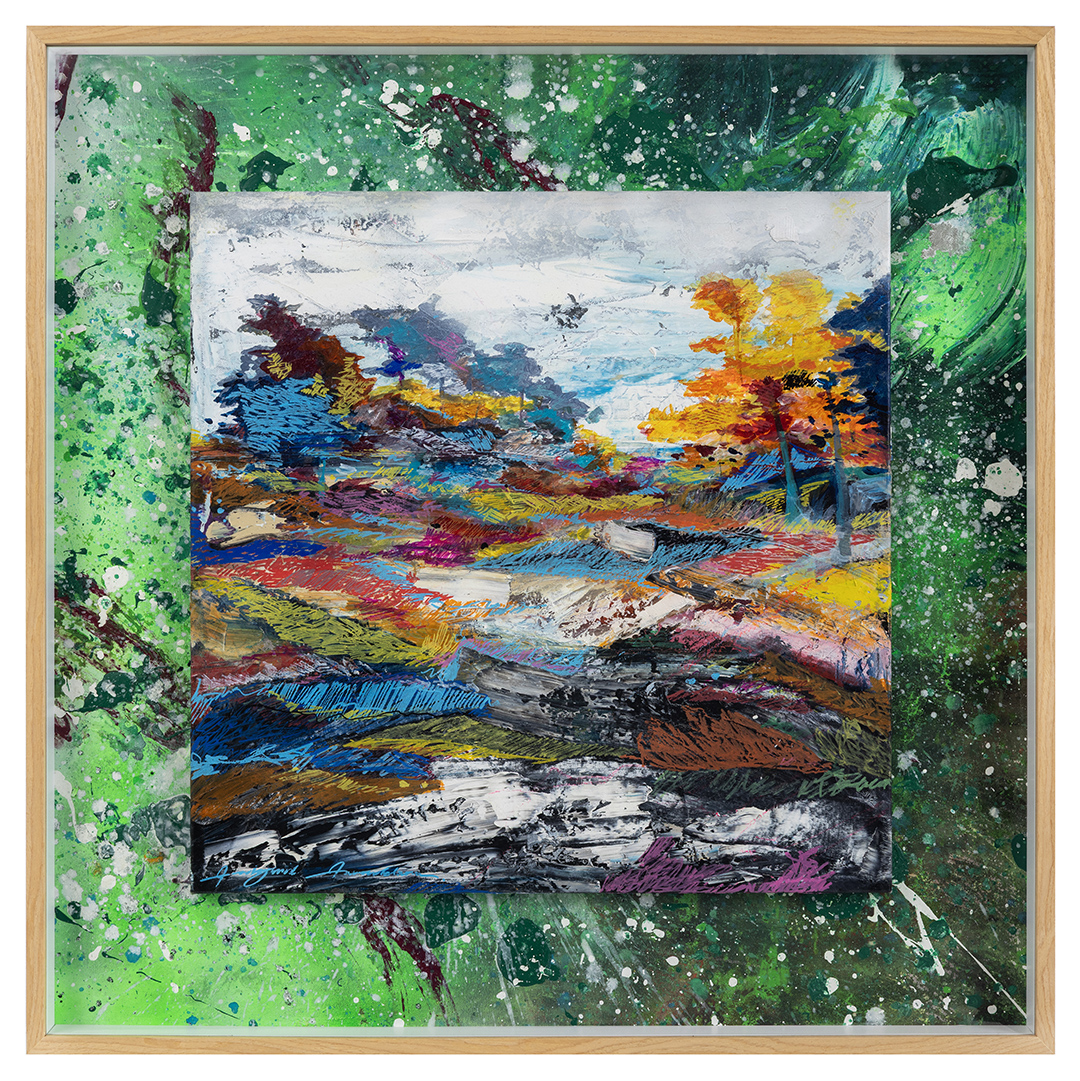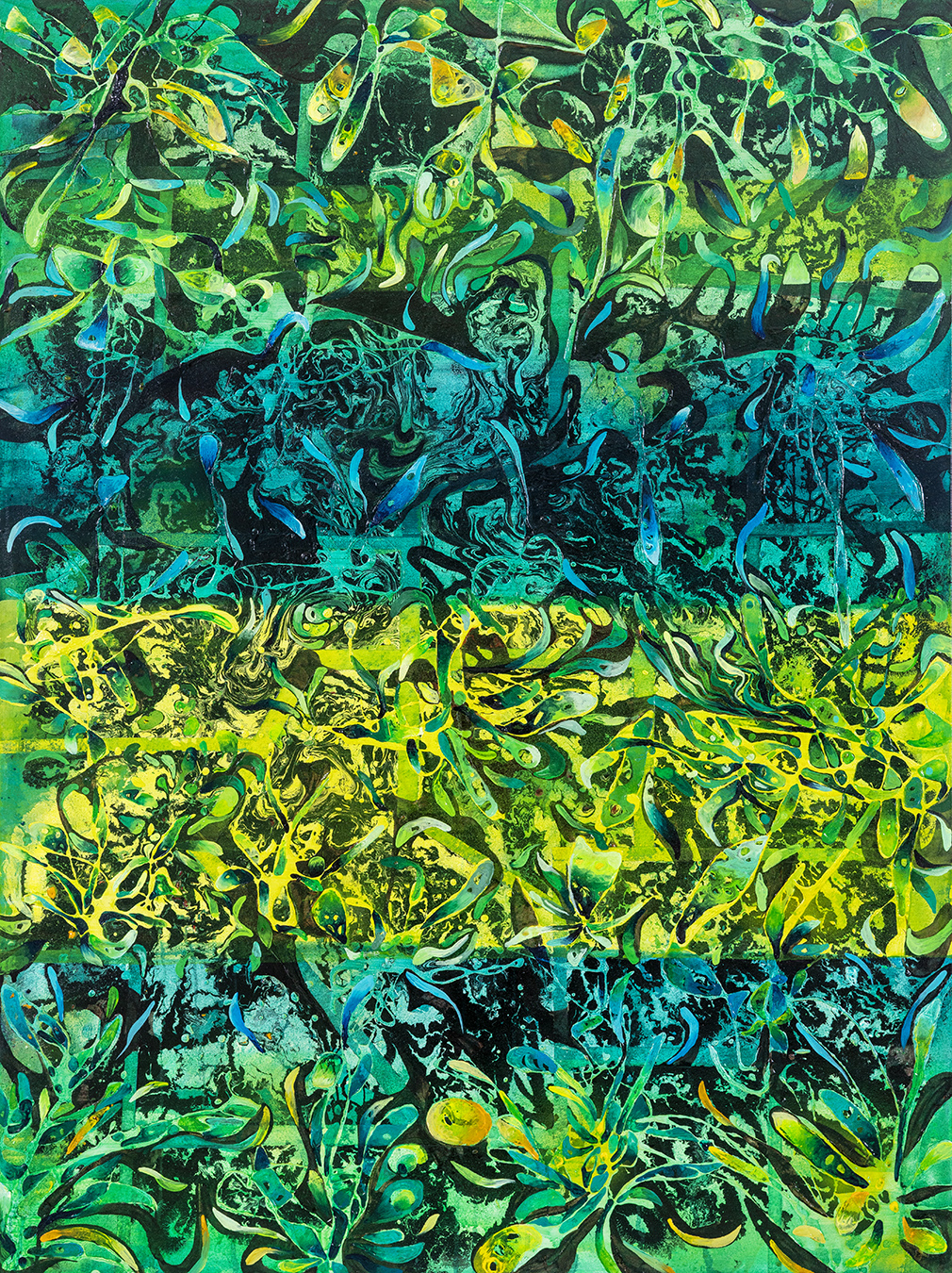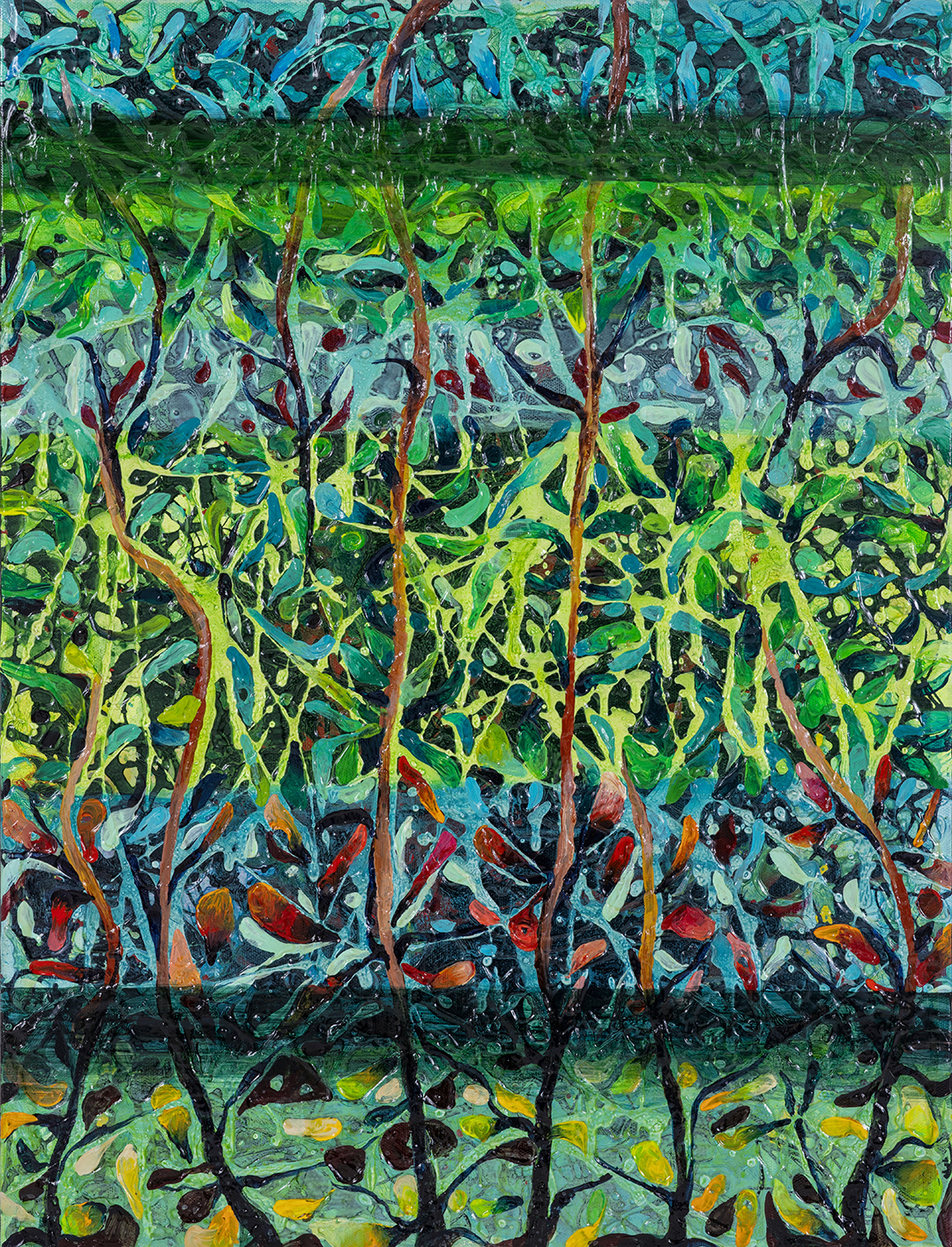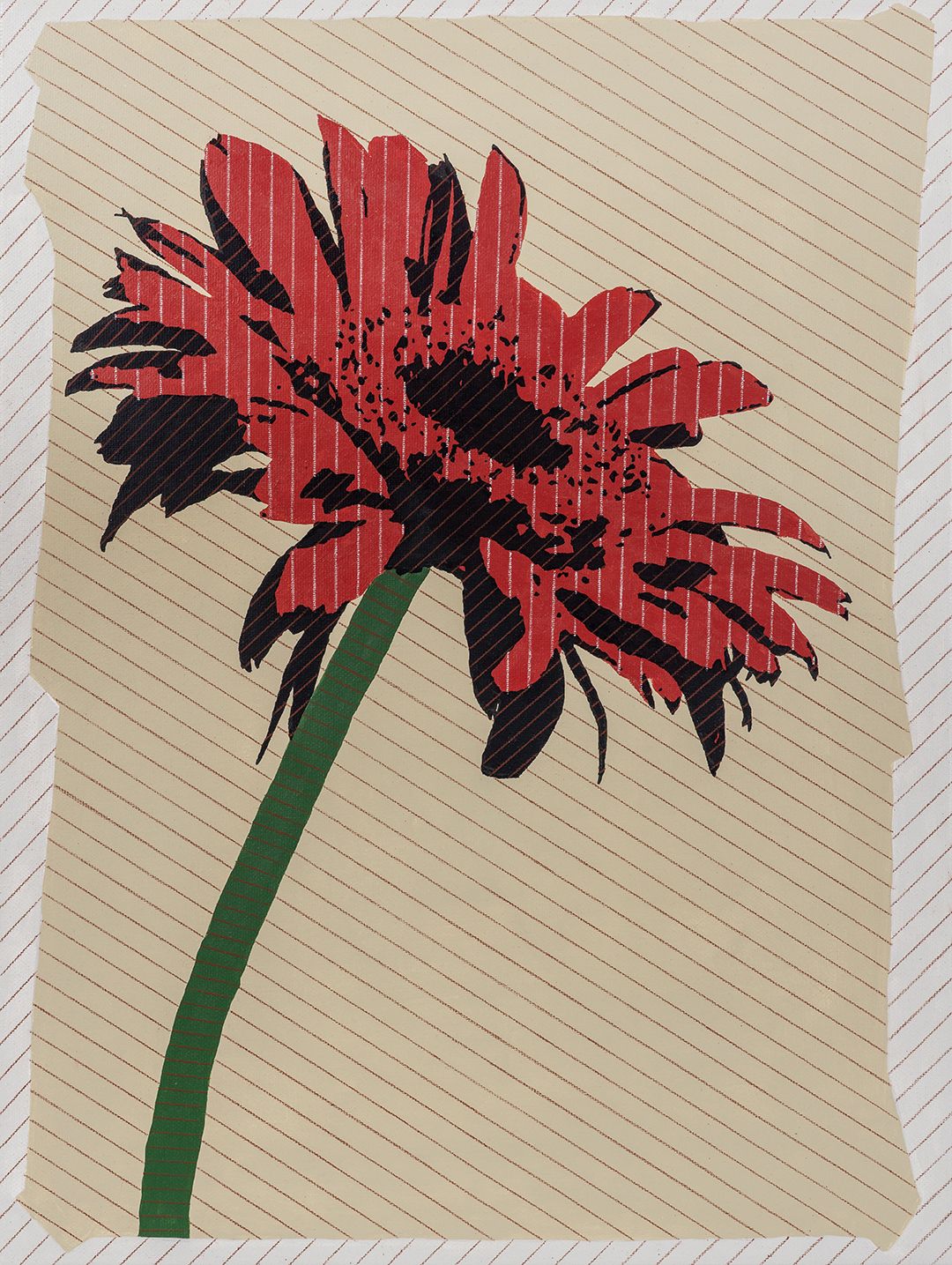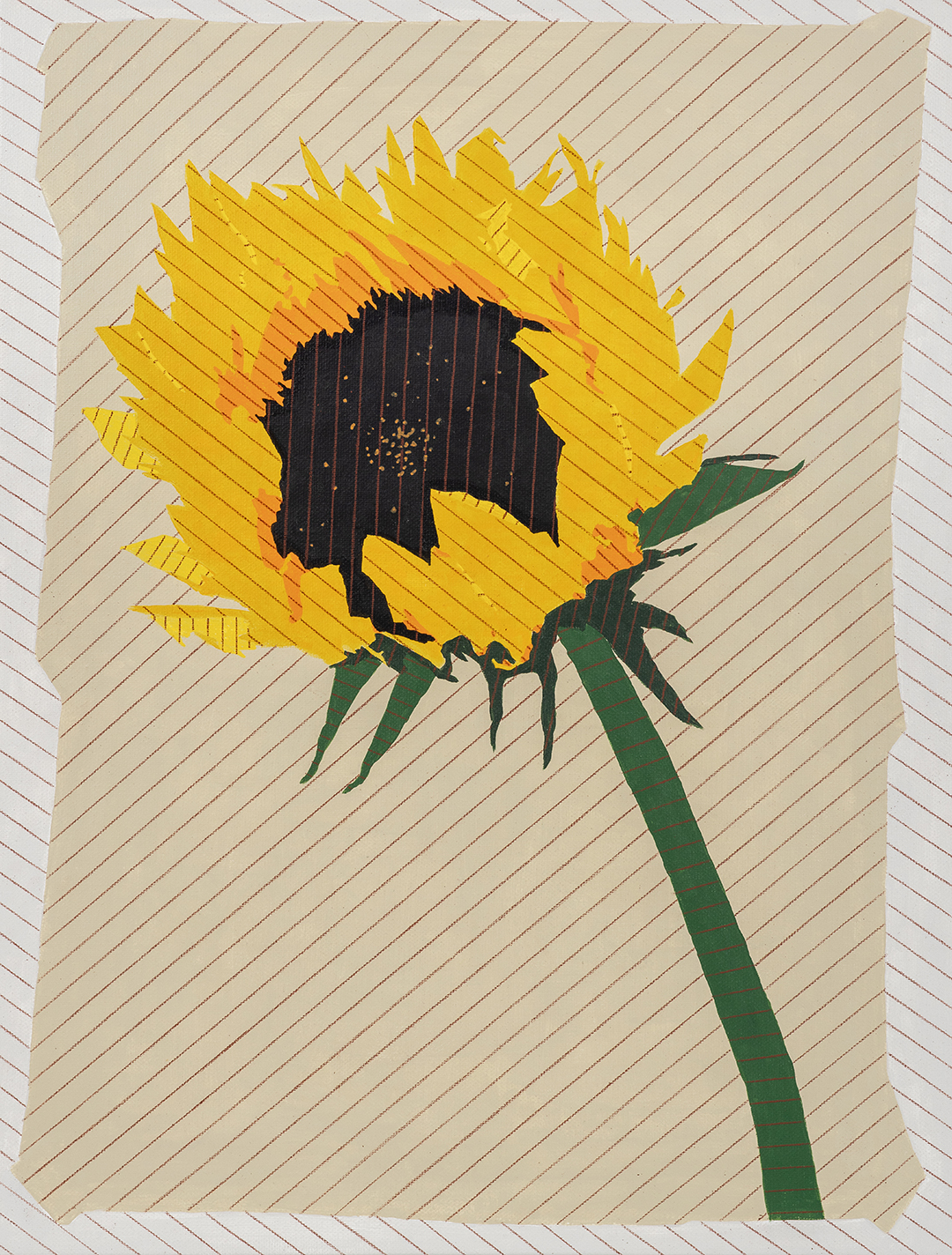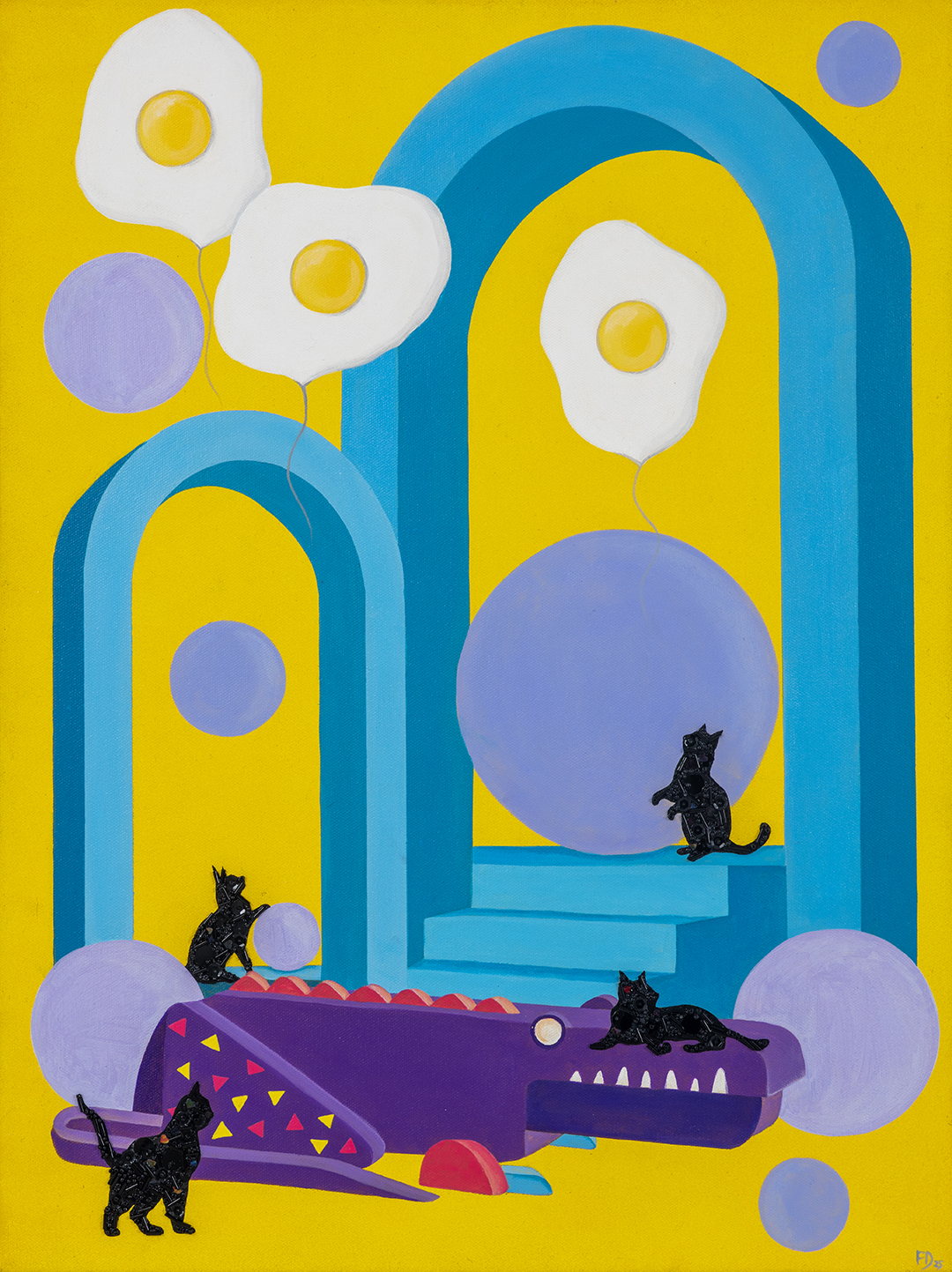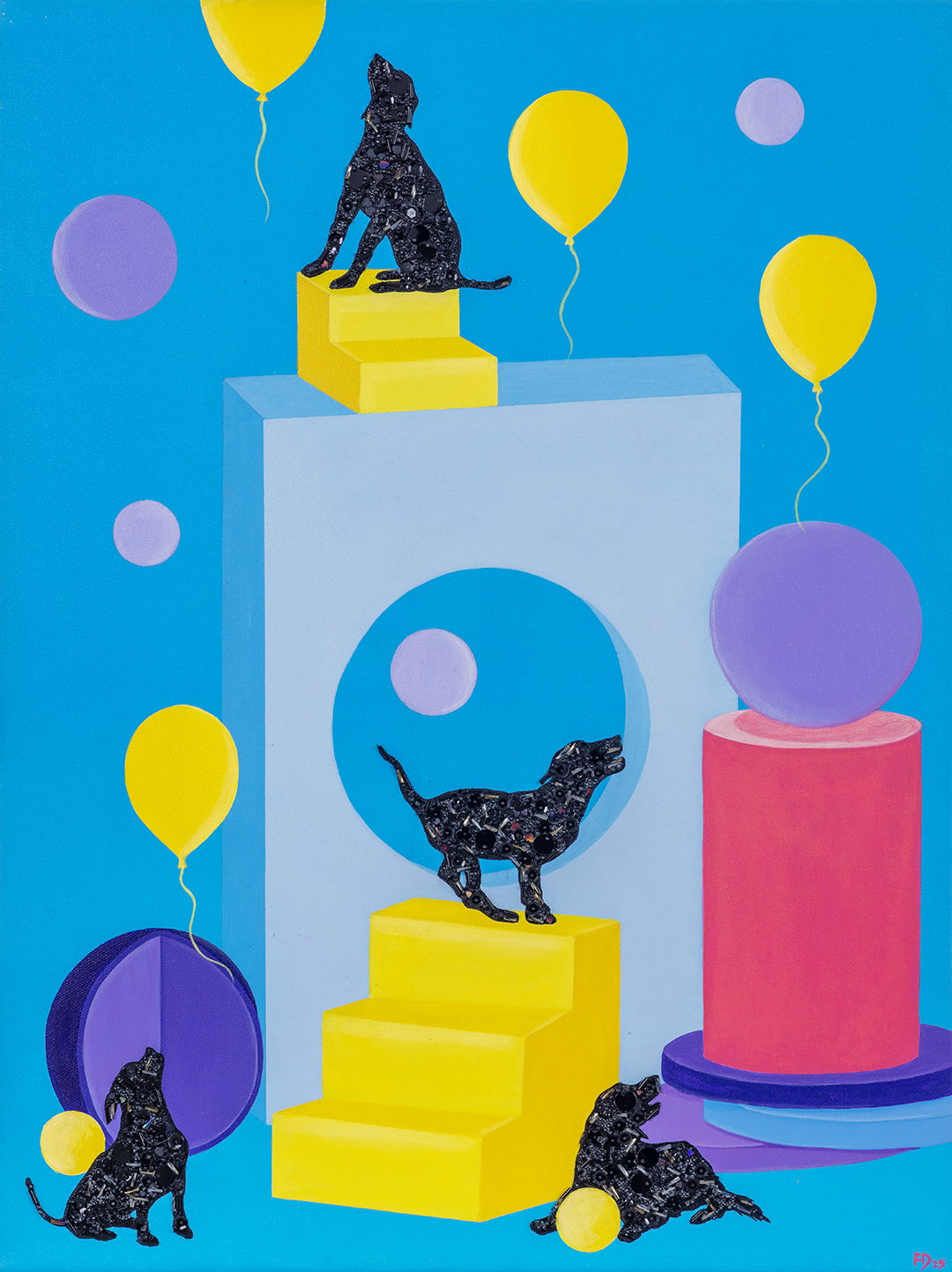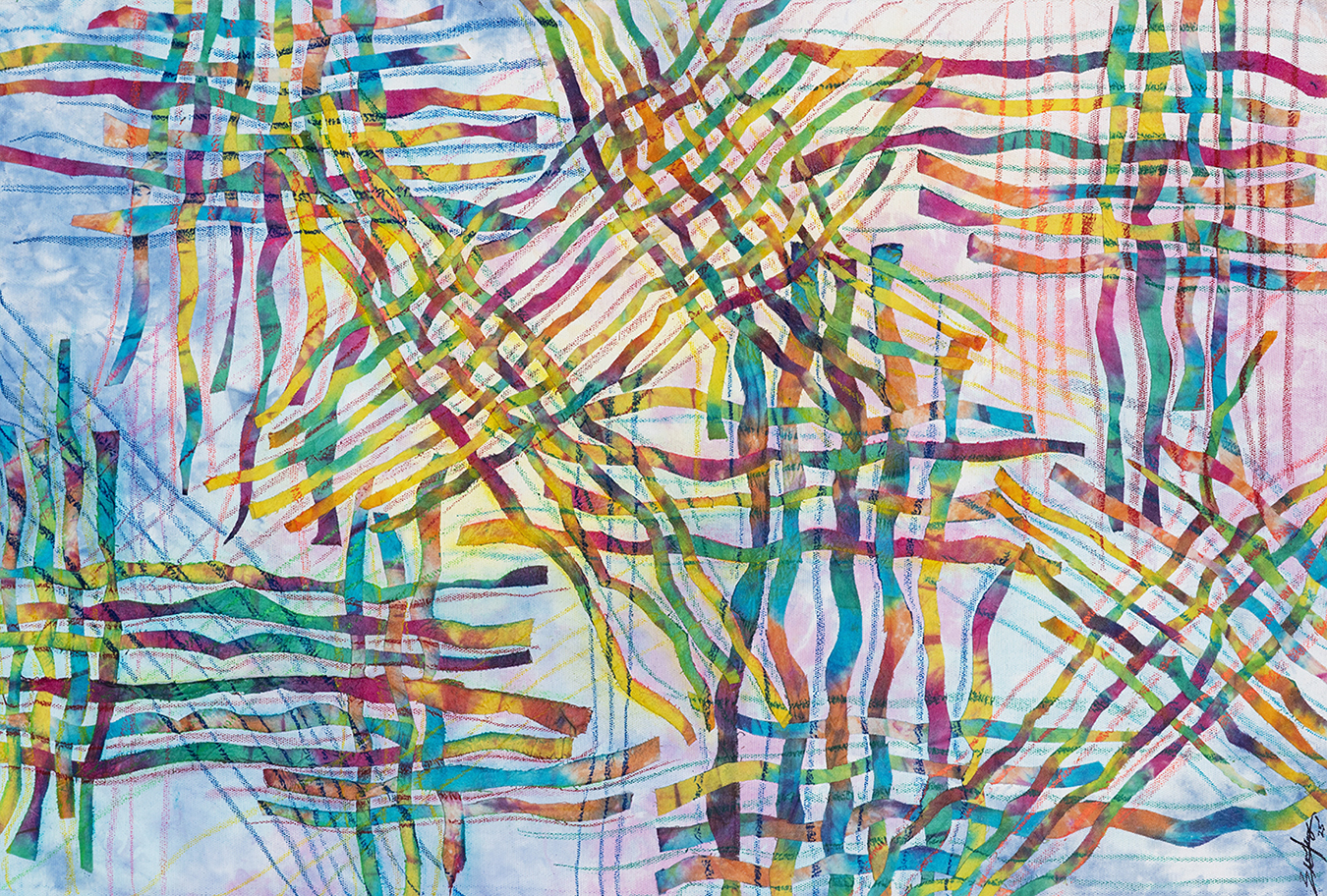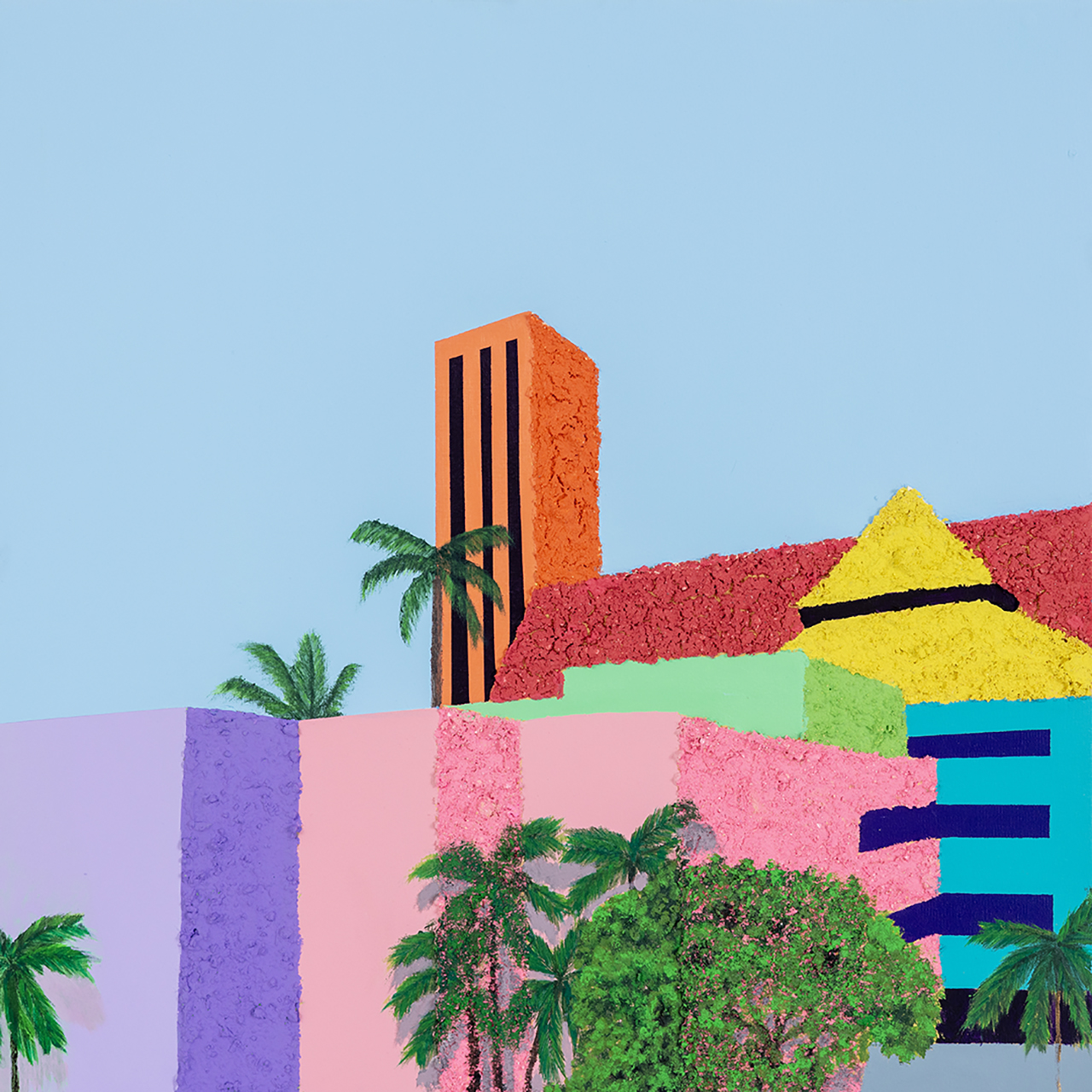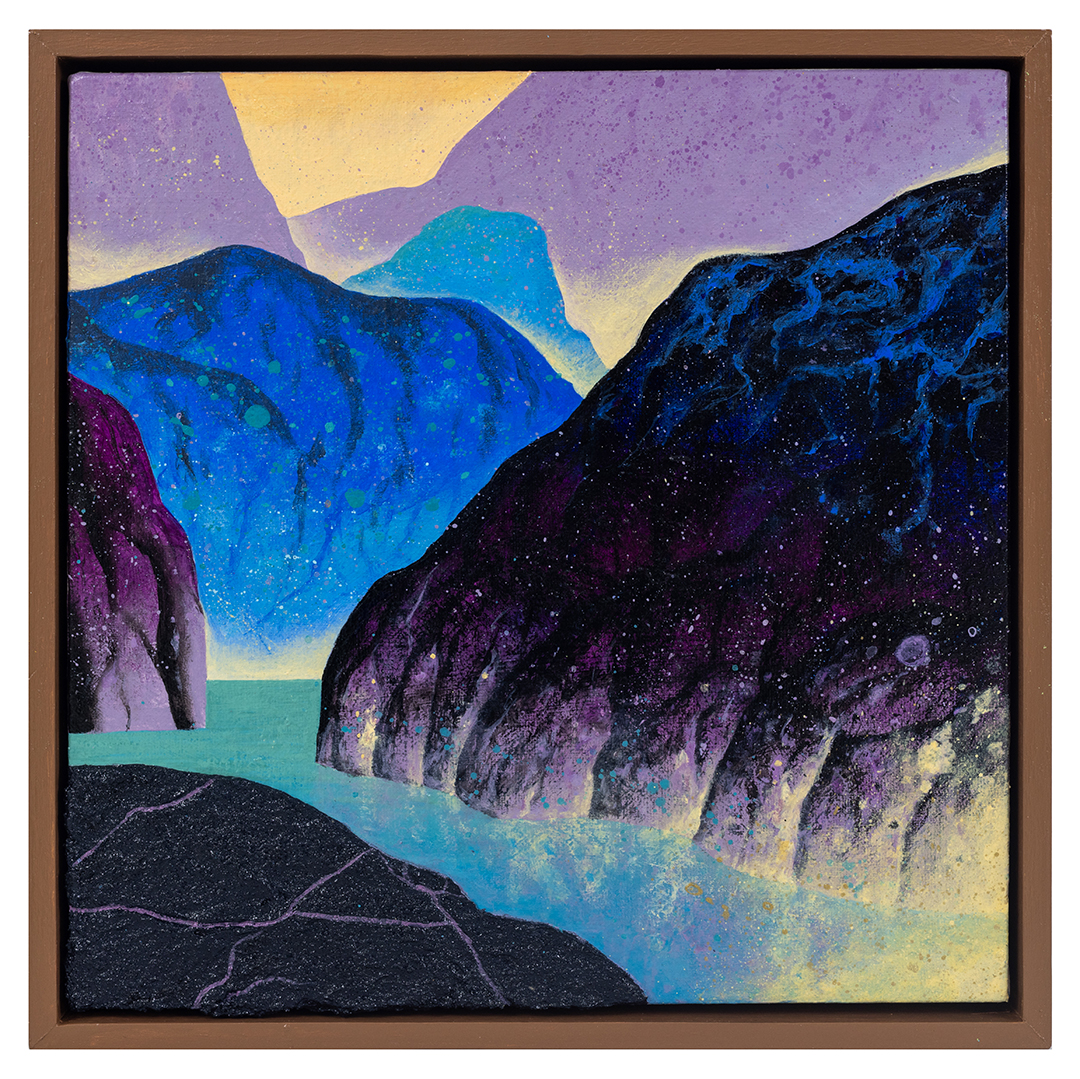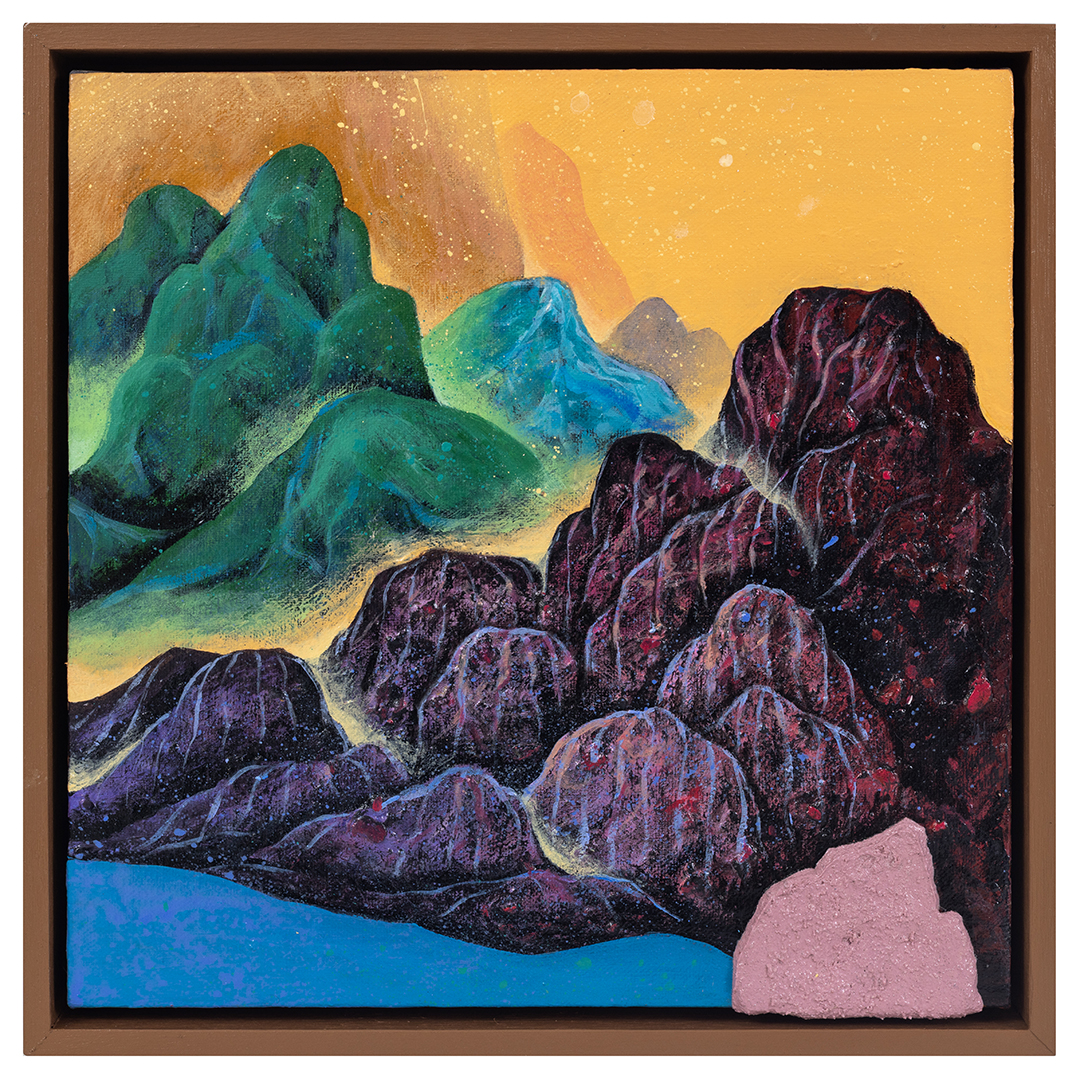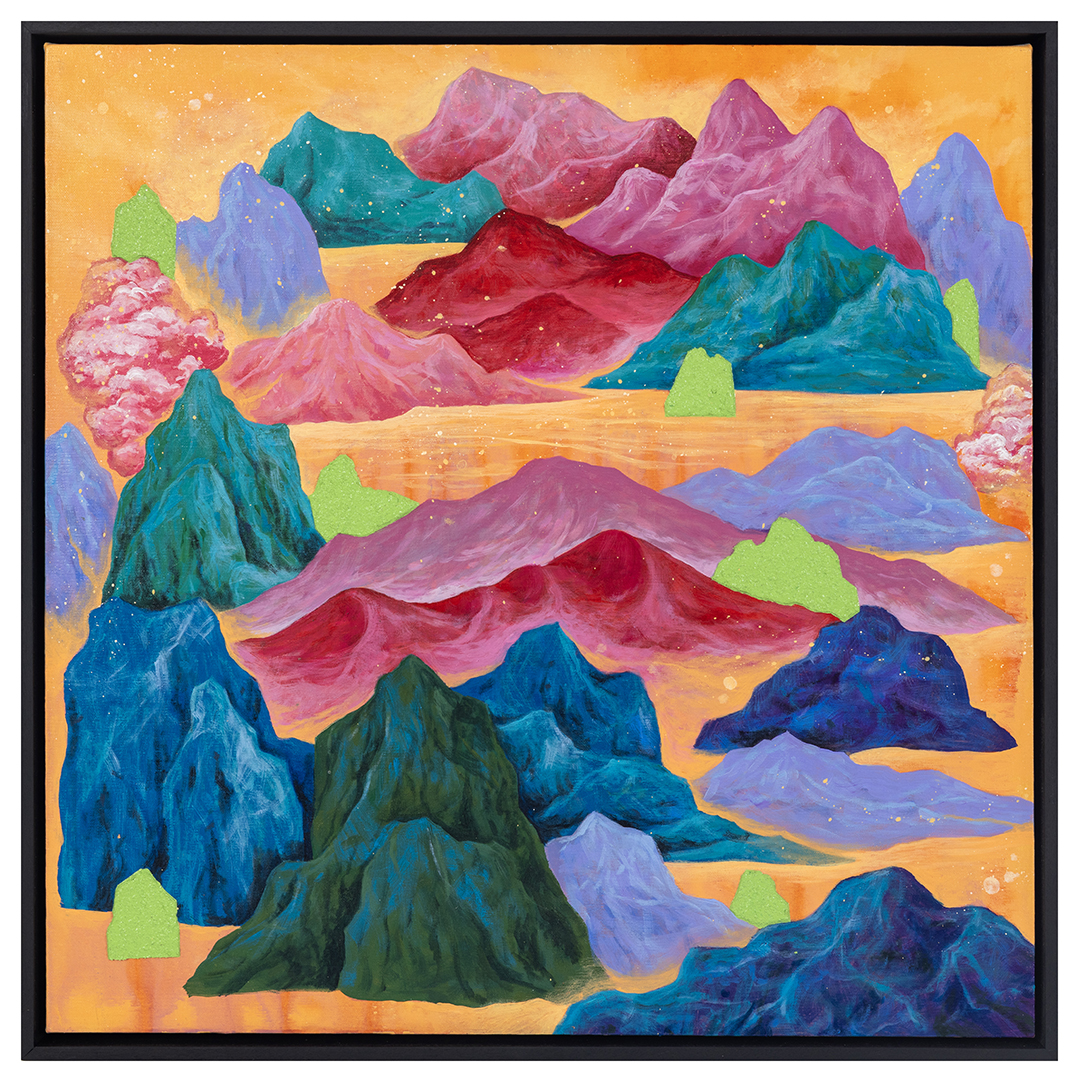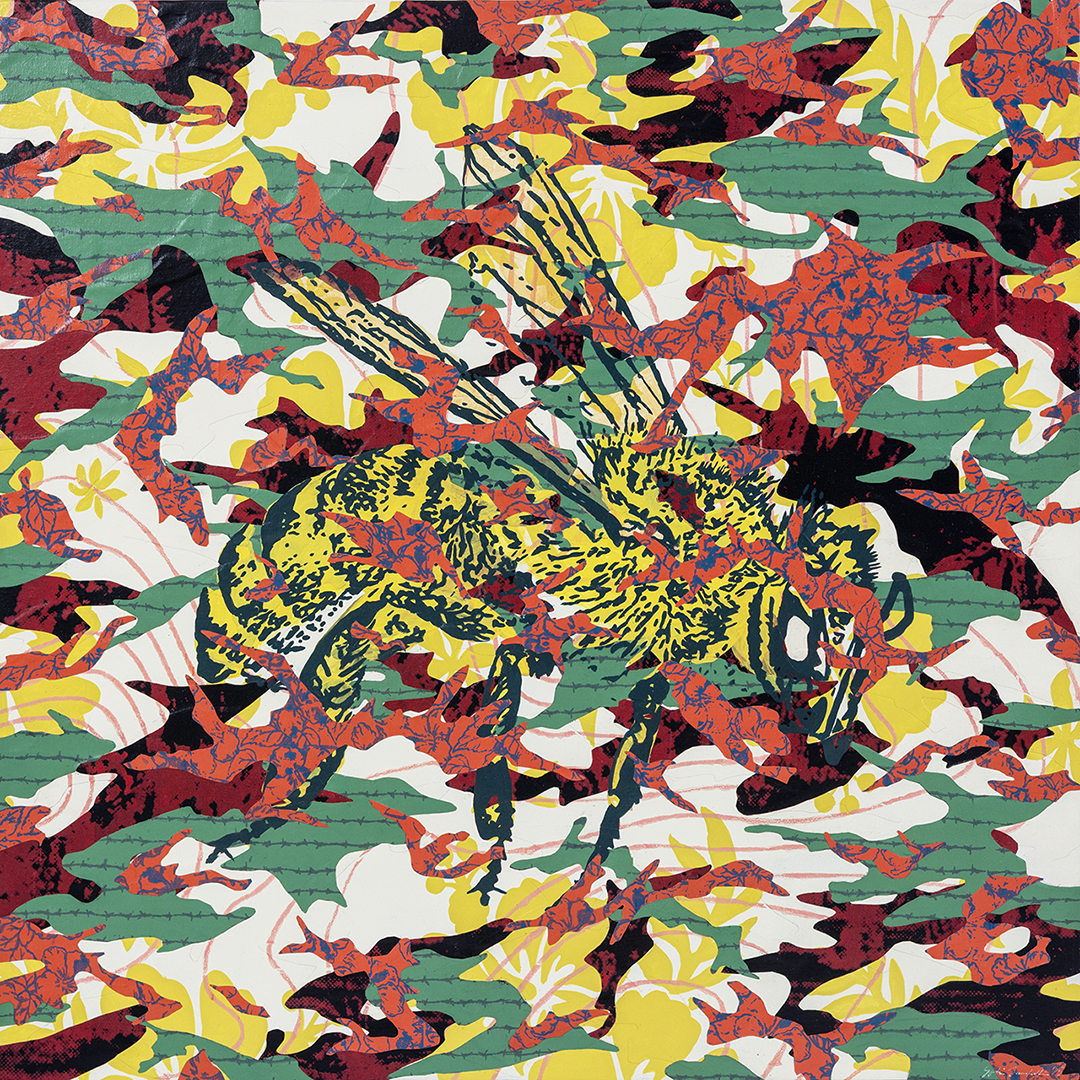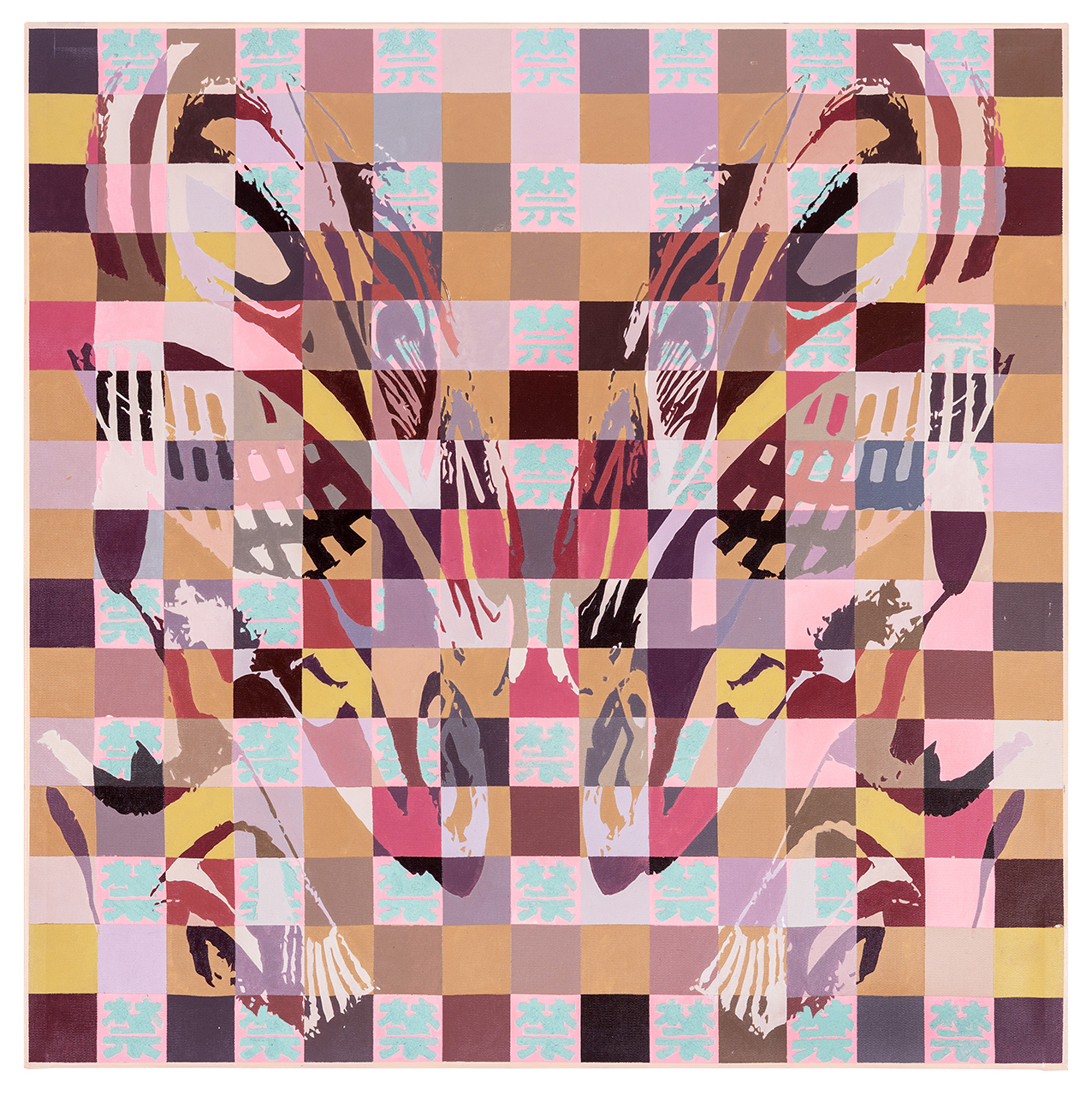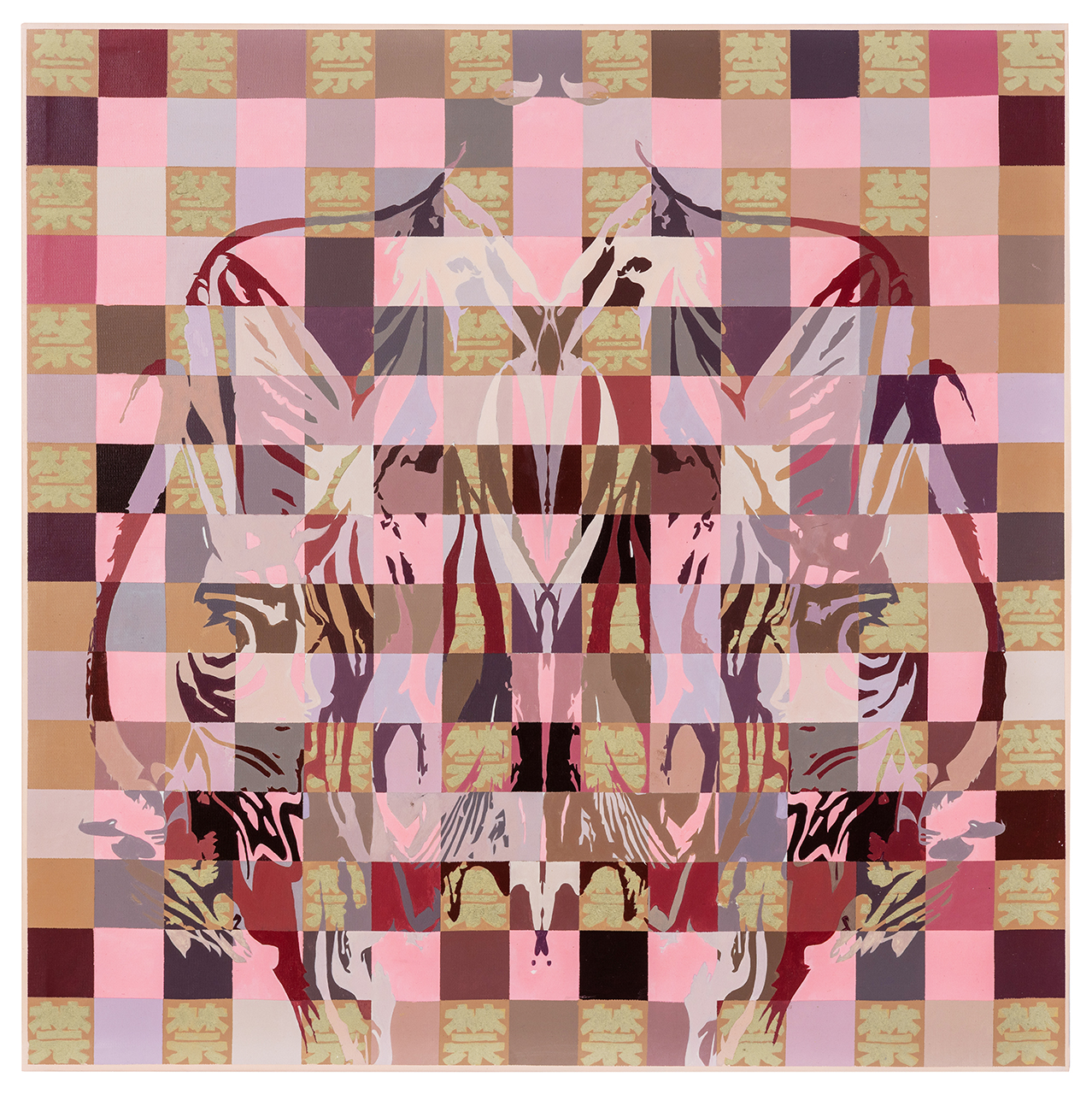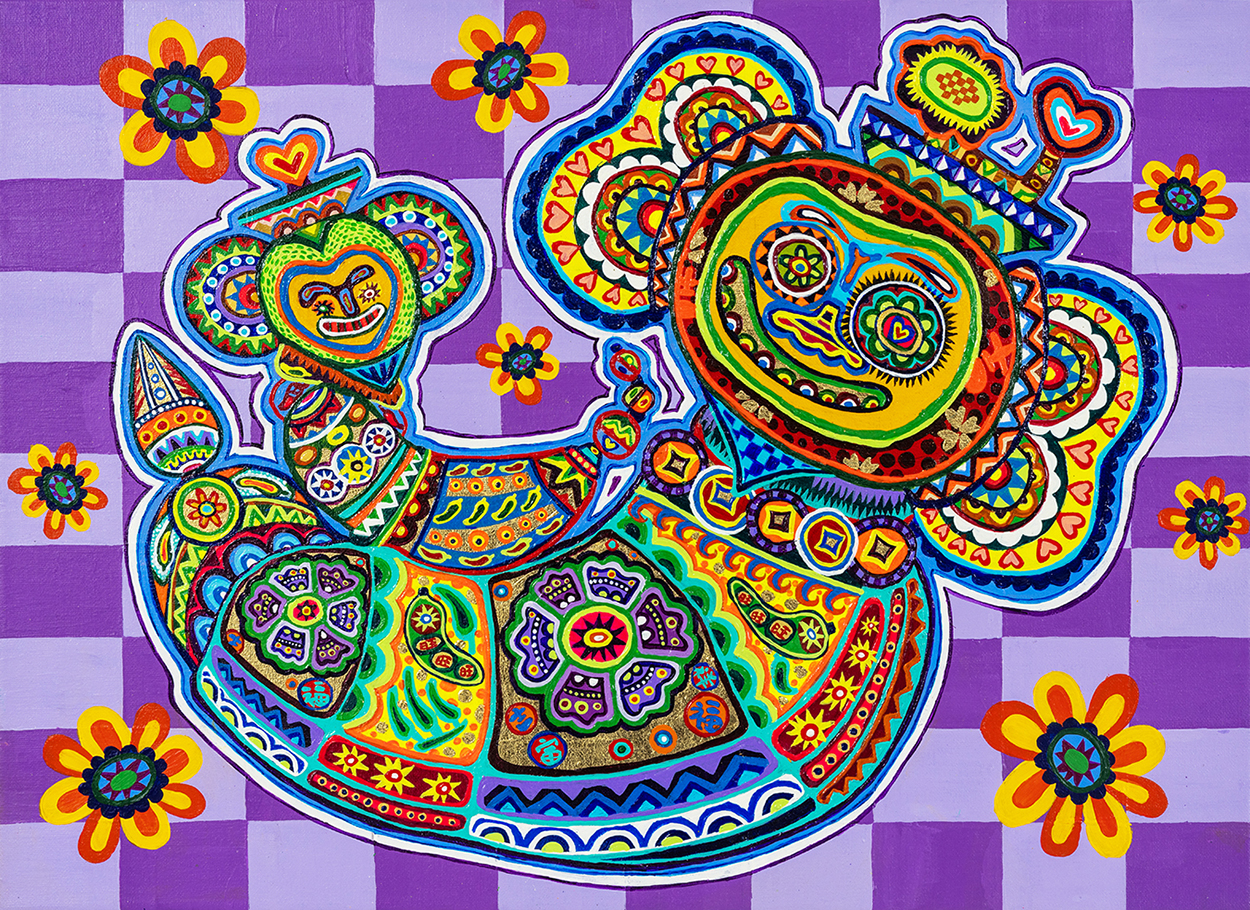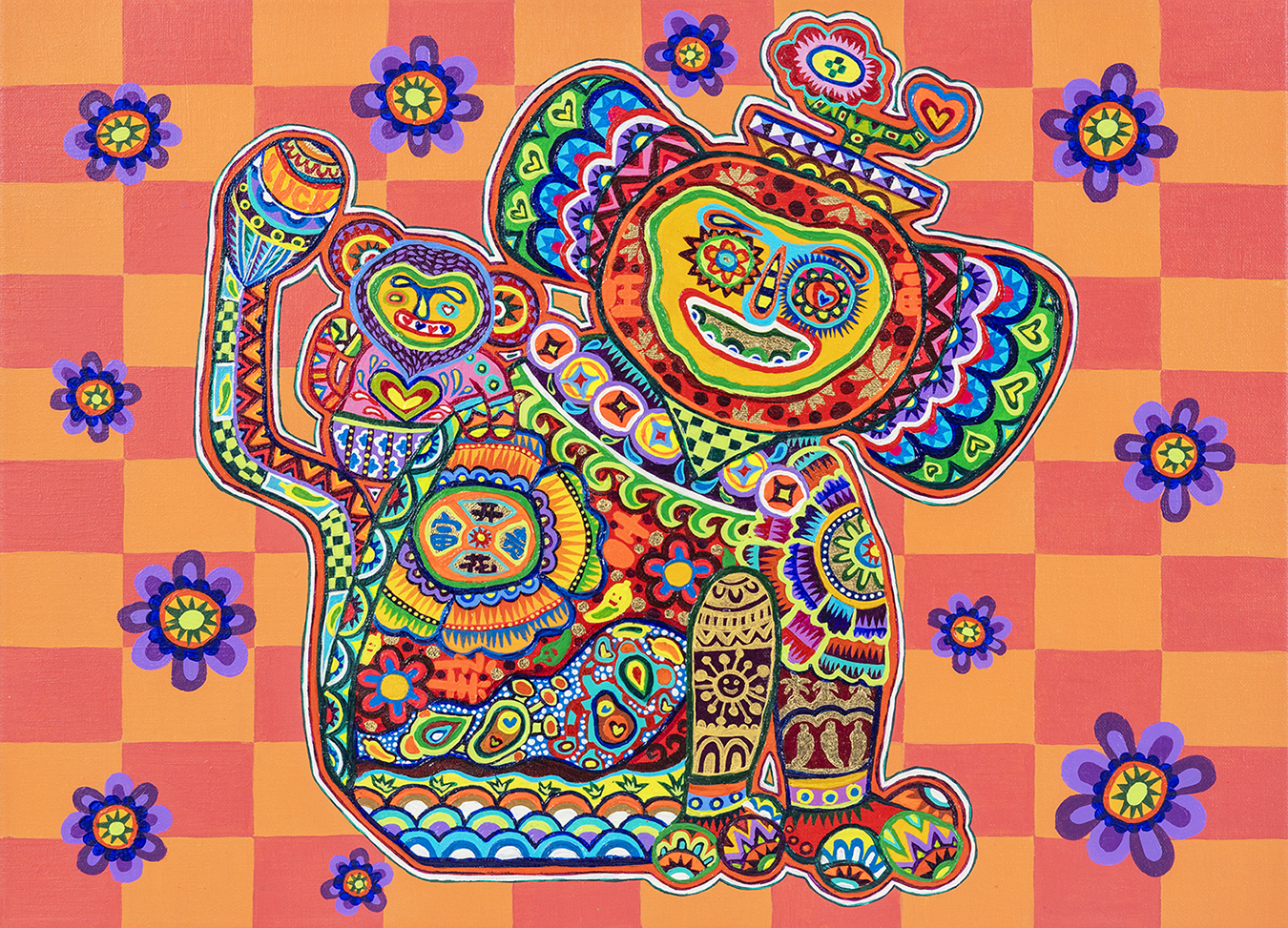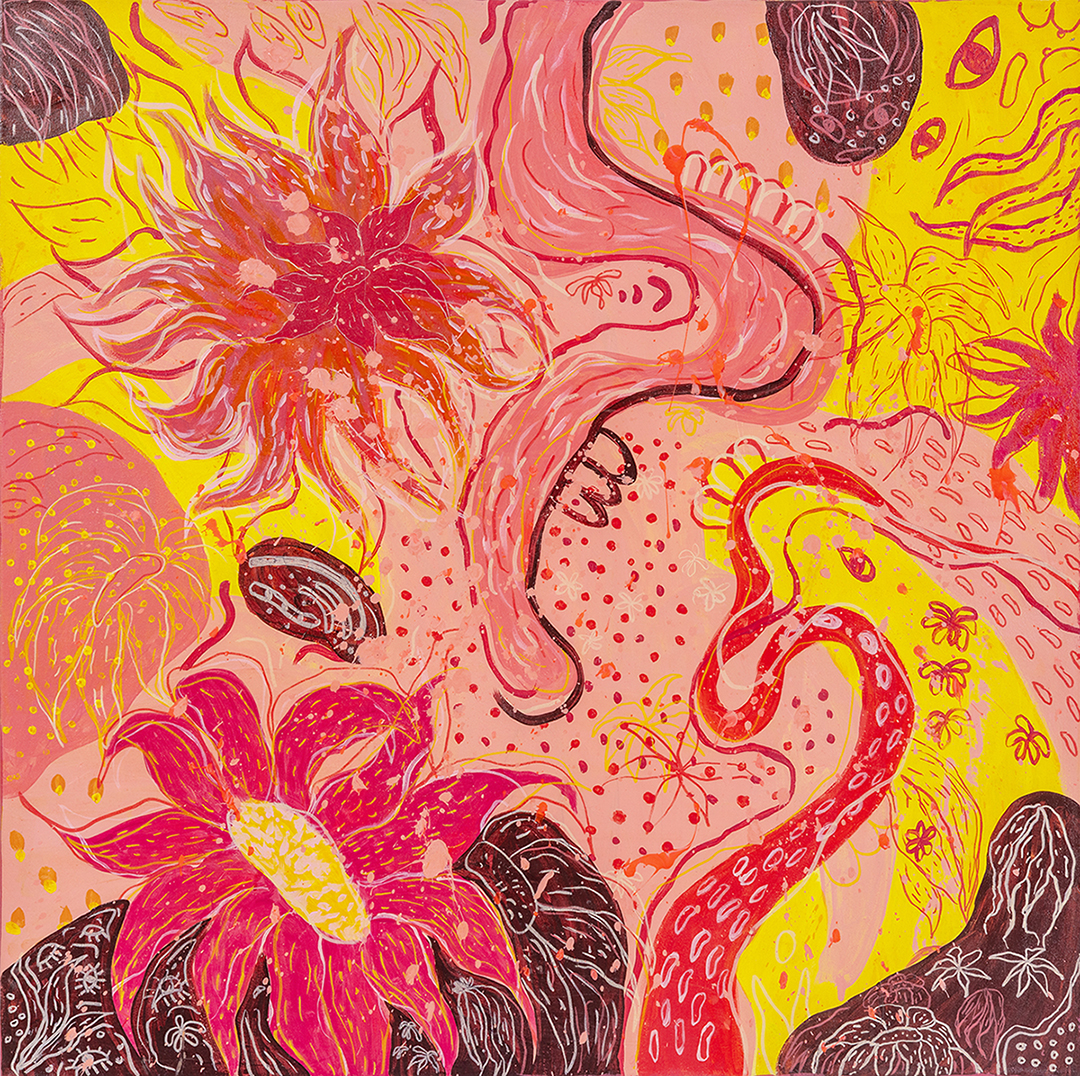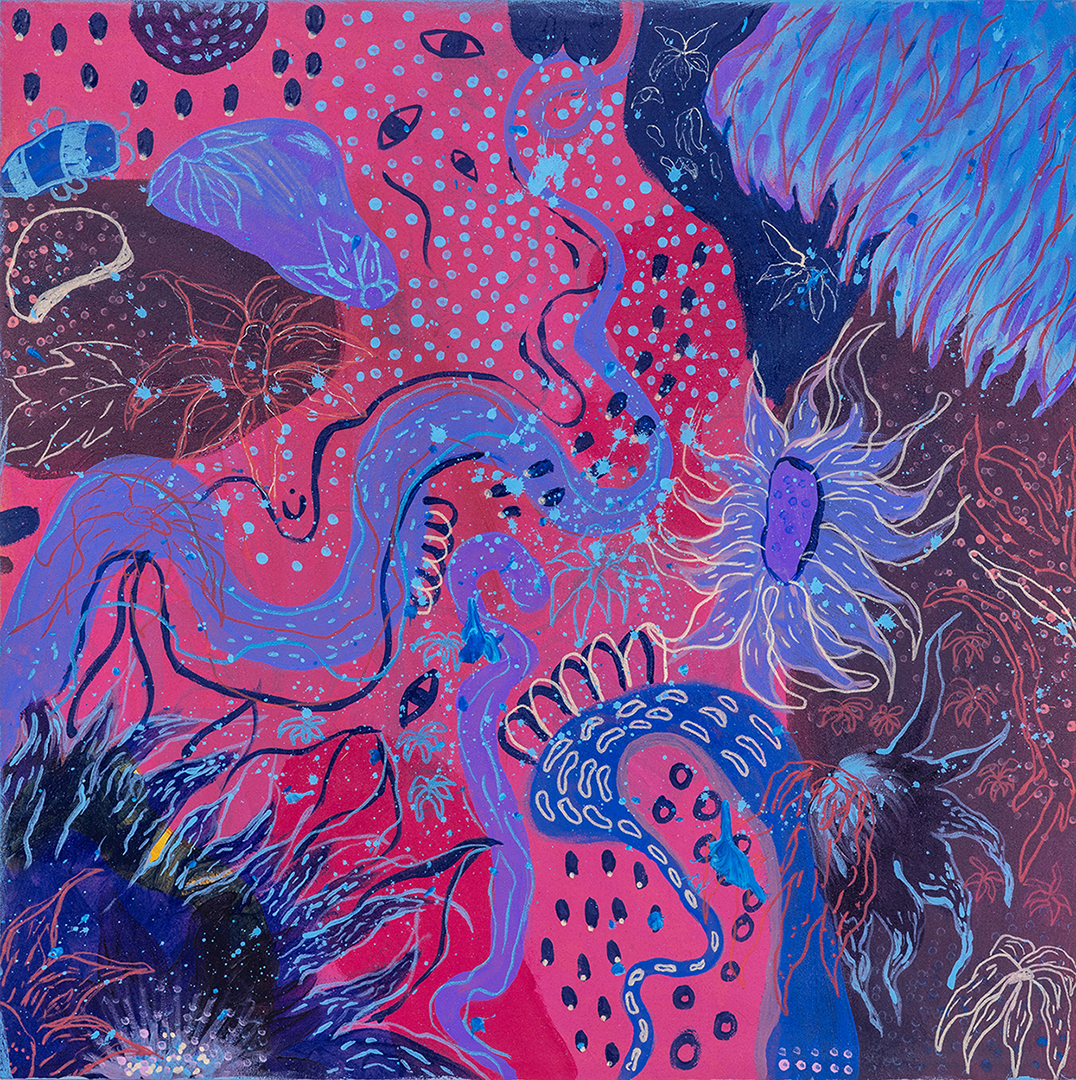Post-Digital Colours (pt. 1)
Group Exhibition:-
Amirul Md Noor
Badrulzzaman Abu
Fadzril Fakaruddin
Faez Fahmi
Fakhriq Zulkifli
Fana Douau
Izzaty Zainudin
Izzuddin Basiron
Shahnaz Azlin
Syahmi Jamaluddin
Tong Xin Lim
Yean Ni Koo
Zharfan Rashidi
23rd August – 20th September 2025
Core Design Gallery, Subang Jaya
*Click on images to zoom in
- Post Digital Colours
In recent years, there has been a noticeable shift in the global visual colour palette, giving rise to a new aesthetic sensibility known as Post-Digital Colours. This emerging concept reflects a growing appreciation for palettes that are simultaneously responsive, immersive, and often only achievable through design software and computer-generated processes. Post-digital colours occupy a unique threshold—straddling the boundary between screen-based artificiality and tangible, analog materiality. This chromatic approach mirrors our deep entanglement with digital interfaces, while also resisting the slick, hyper-perfected visuals commonly associated with purely virtual aesthetics.
In this exhibition, Post-Digital Colours function as a conceptual and visual guide, inviting artists to reflect on and reinterpret the synthetic palettes found in digital environments. Artists explore how colours from digital design tools—clean, sharp, bright hues often seen in RGB displays or four-colour print separations (cyan, magenta, yellow, black)—can be reimagined in physical form. These palettes, often native to screens and software, are examined through various disciplines and each medium transforming digital tones into tactile, material experiences.
Many of the works embrace the visual language of glitch, pixelation, LED glow, and hyper-saturation—yet they are intentionally infused with traces of imperfection, handcraft, and organic irregularity, creating a dialogue between digital precision and human presence. These subtle frictions underscore a larger tension at play: how can technology become part of the artistic process without erasing the mark of the maker? Rather than treating digital colour as static or sterile, the artists in this exhibition imbue it with emotion, memory, and presence—breathing life into what is often perceived as artificial
This exhibition is part of a continuous project that examines how post-digital colour—once confined to the screen—is now spreading into our physical world, reshaping how we see, feel, and create across both digital and analog spaces. It invites viewers to reconsider the nature of colour itself: is it real, simulated, or suspended somewhere in between? As the boundary between virtual and physical realities continues to dissolve, post-digital colours emerge not just as a palette, but as a metaphor—signifying a world in transition, where the human and the synthetic no longer stand in opposition, but collaborate in shaping contemporary visual culture.
As the first iteration of this ongoing project, the exhibition also serves as a platform for artists to experiment, respond, and expand upon the possibilities of post-digital aesthetics. Your contribution plays a critical role in shaping the dialogue around this emerging language of colour—bridging digital influence with material practice, and offering personal, poetic, or political interpretations of a rapidly evolving visual culture.
Rather than providing fixed answers, this exhibition embraces uncertainty, experimentation, and transformation. Your work will become part of a larger conversation—one that challenges conventional boundaries between artificial and organic, digital and handmade, inviting us to imagine new ways of seeing, making, and connecting.
- Amirul Md Noor
Amirul Md. Noor, also known as Amad (b.1996), originating from Kuala Berang, Terengganu. Driven by his passion, he furthered his practice by pursuing a Master’s degree in Fine Art and Technology at UiTM, and is a co-founding members of Empati Studio. Since 2019, his work has explored expressionism through drawing and painting, shifting from paint to charcoal as he became deeply engaged with the human figure and the subtleties of body language. Influenced by nonverbal communication such as dance and physical gesture, his works reflect a fascination with how movement conveys meaning beyond words.
Amad’s artistic journey continues to evolve with explorations that intersect nature, society, and technology. His first solo, Echoes of Resilience, confronted themes of diversity, beauty standards, and social media’s grip on identity, exposing the tensions of contemporary life. In his latest works, Rhizome, inspired by aquascaping, as he examines the balance of structure and chance, where organic forms meet post-digital hues. These disruptions become metaphors for fragile systems—natural, social, and political—framing life as a complex interplay between the artificial and the organic, the beauty and the conflicted.
- Badrulzzaman Abu
Badrulzzaman Abu (b.1995, Sungai Petani, Kedah) earned his Master’s in Fine Art from UiTM Shah Alam in 2019. His practice explores nature’s layers, abstractions, and symbolism, often through bitumen and oil, creating landscapes that shift between chaos and harmony. Flowers and flora are central to his visual language—not only as aesthetic forms but as symbols of life, sustenance, and spiritual fitrah. By abstracting natural elements into layered compositions, his works open space for memory, contemplation, and socio-political reflection on humanity’s bond with nature.
Visually, his paintings are defined by bold brushwork, vibrant non-naturalistic palettes, and surreal undertones that move away from realism toward a poetic simplicity. In his recent works Cosmos in the Garden and Hidden Flower, he deepens this exploration, presenting leaves and blossoms through abstract, organic interpretations. Colors “borrowed” from flora unfold in layered applications—delicate, dense, and translucent—evoking the textures of nature while symbolizing its fragility and resilience. Through this synthesis, Badrulzzaman positions nature as an active presence: a source of beauty, cultural resonance, and urgent reflection on sustainability.
- Fadzril Fakaruddin
Fadzril Fakaruddin, a Pahang-born artist based in Kuala Lumpur, holds a Master’s in Fine Art from UiTM (2020). His artistic journey has led him to participate in numerous exhibitions, competitions, and residencies, including initiatives under Segaris Art Centre and DoubleTree Lakeside Hotel, Putrajaya. Alongside his studio practice, he is also actively involved in art merchandising, expanding the reach of his visual language.
Fadzril’s practice is rooted in mixed media, where layers of canvas, paint, print, and oil pastel converge. Drawing inspiration from Malaysian batik motifs and the natural environment, he constructs semi-abstract landscapes that oscillate between memory, culture, and imagination. Sunflowers and roses frequently emerge as symbolic forms, representing life’s dualities—growth and decay, harmony and disruption—while his vibrant palettes and layered brushwork echo the spirit of Fauvism, infused with a local sensibility.
In his latest series, Fadzril explores the notion of the “mindscape,” transforming jungle visuals, flora, and organic patterns into abstract compositions. Beginning with soft monochromes and developing through splashes, strokes, and translucent layering, his works unfold as endless proliferations of light and form. This process embodies both personal reflection and cultural resonance, positioning nature as therapeutic, symbolic, and deeply tied to identity. Through these explorations, his art communicates narratives of love, memory, and renewal within the contemporary Malaysian context.
- Faez Fahmi
Faez Fahmi (b.1998) is a Kelantan-born Malaysian artist with a Master’s in Fine Art and Technology from UiTM Shah Alam. His practice is deeply informed by his upbringing in Bachok, where the countryside and seaside shaped his sensitivity to light, form, and time. In his debut solo exhibition “Luar Jendela” (“Outside the Window”), Faez translated these experiences into abstract, poetic interpretations that merge cultural heritage with contemporary sensibilities. His distinctive use of white cement for textured surfaces, alongside dripping acrylics and floral references, reflects both the vibrancy of Kelantanese life and his Malay roots.
Faez’s visual language is rooted in sincerity, cultural memory, and personal emotion. He employs humble yet potent materials to explore themes of identity, nature, and harmony, creating works that resonate with depth and immediacy. His practice extends beyond traditional exhibition spaces, appearing in initiatives such as the TRX Canvas Collective, where his experimentation with color, form, and texture bridges personal expression with broader conversations on multicultural urban life.
In his work “Jiwa dan Bayang”, Faez delves into the delicate interplay between the visible and the hidden. Through layered contrasts of light and shadow, warm and cool tones, and dynamic compositions of line and texture, he evokes both presence and absence. Here, shadow emerges as more than darkness—it becomes a metaphor for memory, doubt, and unspoken emotions. The work reminds us that human identity is always shaped in the dialogue between soul and shadow, light and dark, clarity and obscurity, where meaning and truth quietly unfold.
- Fakhriq Zulkifli
Fakhriq Zulkifli (b. 1993) is a Malaysian contemporary fine artist who earned his Bachelor of Fine Arts from Universiti Teknologi MARA (UiTM) Perak in 2016. Since then, he has been actively engaged in the art scene, participating in prestigious art fairs, competitions, and exhibitions both locally and internationally. His practice reflects a deep exploration of personal character and lived experiences, often conveyed through carefully chosen materials that heighten the thematic and emotional resonance of his works. By intertwining memory, symbolism, and materiality, Fakhriq’s art seeks to inspire emotions, rekindle reflection, and create an intimate connection with viewers.
“The Silent Flower I & II” embody a meditation on resilience, fragility, and the quiet strength found in stillness. Using acrylic and dermatograph pencil on canvas, Fakhriq reimagines the flower not merely as a natural form but as a symbol of endurance and vulnerability, rendered through bold silhouettes and rhythmic linework. The tension between softness and structure mirrors the artist’s own reflections on identity and lived experience—where silence becomes a language, and fragility transforms into strength. Through these works, the flower emerges as both a personal metaphor and a universal reminder of beauty’s quiet persistence in the face of time and change.
- Fana Douau
Fana Douau (b.1990) is an emerging artist from Malacca, Malaysia, known for her vibrant and expressive art pieces. She completed her Diploma in Fine Art at the renowned Malaysian Institute of Art (M.I.A) in 2021. In her earlier works, Fana was deeply influenced by the post-impressionist style, focusing primarily on nature as her subject matter. Over time, her artistic approach evolved as she began experimenting with various techniques and materials, including acrylics, charcoal, fumage, and beadwork. This exploration has shaped her current style, which centers around joyful, emotionally resonant subjects like pets, particularly cats and dogs. Fana uses bright, brilliant colors to convey happiness and emotion directly from her heart to the canvas, creating art that is both exhilarating and uplifting for viewers.
“Playground of Joy: Cats and Dogs” is a celebration of innocence, companionship, and the boundless freedom of imagination. Inspired by the way cats and dogs inhabit the world—with wonder as their language and play as their purpose—the work transforms the playground into a metaphorical space of shared happiness. Through color, form, and movement, it captures fleeting yet profound moments of joy that bloom unapologetically, free from self-consciousness. In a world often burdened by seriousness, this work invites viewers to step back into simplicity and remember that joy is not found—it is created, together.
- Izzaty Zainudin
Izzaty Zainudin (b. 2001) is a Selangor-born emerging artist who graduated with a BA (Hons) in Fine Arts in 2024. Her practice incorporates upcycled materials such as old clothes, cut canvas, and hand-sewn elements, emphasizing sustainability while weaving personal and cultural narratives into her process. By embracing imperfection and organic irregularity, Izzaty’s works embody both playfulness and sincerity, reflecting a contemporary sensibility grounded in material experimentation.
“In every universe, I will always be your…” draws inspiration from the post-digital colours found in cinematic media, particularly the acclaimed film Everything Everywhere All at Once (dir. Daniel Scheinert & Daniel Kwan). This work reinterprets the film’s vibrant, layered aesthetic as a visual language to explore multi-realities, emotional depth, and the transitions of life. The use of colour becomes central—simultaneously playful and purposeful—while upcycled materials and sewn textures underscore the artist’s appreciation for spontaneity and imperfection in contemporary art.
The phrase “In every universe, I will always be your…” invites open interpretation, resonating with viewers according to their own emotional state. It speaks to the multiplicity of roles within relationships—mother, friend, lover, rival—and to the continuity of connection across different phases of life. Through this interplay of colour, material, and meaning, Izzaty’s work highlights how visual language can transcend aesthetics to evoke profound emotional and relational experiences.
- Izzuddin Basiron
Izzuddin Basiron (b. 1994) is a rising contemporary artist with a strong foundation in fine art, holding a Bachelor of Fine Art from Universiti Teknologi MARA (UiTM). Known for his compelling and visually striking works, he has presented notable solo exhibitions including Kota Kromatik (2023) and Bricks Symphony (2024). His fascination with Brutalist architecture informs his practice, where sharp geometric designs and monumental forms become central to his visual language. This architectural influence is reimagined through vibrant palettes, resulting in works that fuse structural precision with expressive energy. Recognized as one of the 13 Best Artists in the Malaysia Emerging Artist Award (MEAA) 2022, and showcased internationally at Art Formosa in Taiwan, Izzuddin continues to establish himself as a distinctive voice in contemporary art.
City in Technicolour reimagines the urban landscape as a vibrant, living entity where architecture transcends muted rigidity to pulse with bold, tropical colours. Geometric forms and palm trees converge in playful chaos, reflecting a city infused with warmth, rhythm, and imagination. This work challenges conventional perceptions of urban spaces, suggesting that cities are not merely built from concrete and steel, but also from the dreams, emotions, and vibrant energies of those who inhabit them.
- Shahnaz Azlin
Shahnaz Azlin (b. 1995, Kedah, Malaysia) is a visual artist whose practice reflects a deep engagement with the phenomenology of landscapes. He graduated with a BA in Fine Art from UiTM Shah Alam in 2018, following his diploma studies at UiTM Seri Iskandar, Perak, where he was actively involved in institutional exhibitions. His early career was shaped by international exposure through an internship with Saung Banon Arts in Yogyakarta, Indonesia (2017), and that same year, he was a finalist in the MiDF competition. Since then, he has participated in various art initiatives, including Bakat Muda Sezaman (2021), where he received the People’s Choice Award, and the Mr. DIY Art Competition (2023), where he earned a Special Mention.
Shahnaz’s practice currently explores the layered qualities of landscapes, where the act of seeing becomes a journey of perception and memory. Through the concept of “Lapisan” (layers), he examines how mountains, skies, and horizons unfold as metaphors for time, solitude, and experience. His textural works embody both stillness and movement, inviting viewers to traverse the space between the real and the imagined, the fleeting and the eternal.
Each composition forms a kind of “Gugusan”, a gathering of layered moments that resonate with balance, rhythm, and quiet harmony. Drawing deeply from nature’s essence, Shahnaz’s works offer contemplative spaces that reflect not only the external land before us but also the inner landscapes carried within—of memory, discovery, and horizons that continually open to new beginnings.
- Syahmi Jamaluddin
Syahimi Jamaluddin (b. 1993, Batu Pahat, Johor) graduated from UiTM in 2016 with a Diploma in Fine Art (Painting). Even before completing his studies, he had begun to gain recognition within the Malaysian contemporary art scene through exhibitions and awards. Notably, in 2015 he received both the Grand Award and the Galeri Petronas Director’s Award at the Energy Future, Past and Present Competition held at Petronas Gallery, Kuala Lumpur, where he was also named “Potential Breakout Artist”. His trajectory has continued to grow, with a significant milestone in 2022 when he was awarded the Malaysian Emerging Artist Award (MEA) by HOM Art Trans, in partnership with CIMB Foundation.
Syahimi’s artistic practice extends the conventional boundaries of printmaking through experimentation with diverse materials and techniques. Influenced by the pioneering works of Robert Rauschenberg and Malaysian contemporary artist Zulkifli Yusof, he adopts their spirit of innovation in layering printmaking with other mediums. His approach often merges painted areas with printed overlays, producing rich textures and dimensionality within the pictorial plane. In his recent explorations, Syahimi has pushed this further by layering Perspex over canvas, printing across multiple surfaces to create imagery that shifts with depth and light — a method that adds new meaning to the phrase “layers of seeing.”
His work “An Attemptness to Taste the Sweetness” reflects this experimental language. At its center is the bee, a symbol of tireless labor, community, and the creation of sweetness. Set against overlapping patterns that echo both camouflage and natural forms, the bee emerges and dissolves within turbulent layers, embodying the fragile yet persistent human desire to grasp beauty amidst chaos. The work speaks to resilience and perseverance, suggesting that the pursuit of joy and sustenance often requires navigating complexity and uncertainty before arriving at moments of clarity and sweetness.
- Tong Xin Lim
Tong Xin Lim is an emerging Malaysian artist whose practice blends traditional and contemporary elements to explore themes of identity, culture, and personal experience. Born in Malaysia, she pursued formal training in fine arts, where she cultivated a distinctive visual language characterized by intricate detail and a sensitive use of mixed media. Tong’s works often reflect her cultural heritage while responding to the complexities of contemporary life, creating layered visual narratives that resonate with both personal and collective memory. Her art is known for its emotional depth and its ability to invite viewers into moments of reflection on their own identities and surroundings.
In her latest series, Tong examines the emotional and cultural nuances of Malaysia’s multi-ethnic society. Through layered abstraction, symbolic motifs, and restrained composition, she reflects on the ways individuals and communities share space while honoring differences. Her works are inspired by the dual meaning of the Chinese phrase 禁距离 (forbidden/close distance), a paradox that encapsulates the tension between intimacy and separation, familiarity and distance.
Sacred animals, culturally charged symbols, and subtle exchanges of gaze recur as metaphors in her visual storytelling. These motifs become bridges across cultural and emotional divides, evoking moments of quiet coexistence where difference is acknowledged rather than erased. Rather than suggesting assimilation, Tong presents identity as layered, fluid, and complex. In this way, her work becomes an invitation to reconsider proximity — not as sameness, but as a willingness to see, respect, and care across difference.
- Yean Ni Koo
Born in 1994, Yean Ni Koo is a fine art graduate from Dasein Academy of Art who has been dedicated to her practice since her student years. Since graduating in 2015, she has actively participated in numerous local group exhibitions and has recently expanded her reach to Hong Kong and Shanghai. In 2016, she held her first solo exhibition at Findars Art Space. Her achievements include winning first prize in the Petron Art Competition (painting category) and first runner-up in the Maybank Hari Raya Aidilfitri Creative Wau Design Competition. She has also been selected for several prestigious competitions in Malaysia, such as Bank Negara’s Tanpa Nama 2 and the Nando’s Art Initiative.
Koo Yean Ni’s work draws inspiration from the naïve, pure, and innocent qualities of folk art and children’s art. Her vibrant paintings, collages, and embroidery works reflect a spontaneous and unconstrained approach, shaped by her love for folk traditions and years of observing children’s creativity through teaching. Embracing everyday life, cultural memory, and traditions of her homeland, she records and preserves socially significant moments through a joyful process of imaginative play. Her works carry anthological, nostalgic, and sentimental qualities, inviting viewers into a world of warmth and sincerity.
The Joyful Guardians series celebrates companionship, protection, and emotional healing through playful imagery and vibrant colors. Characters combining elements of animals, toys, and human emotions embody guardian spirits with innocent yet determined expressions—symbols of quiet strength that accompany us through life’s stages. Checkerboard patterns and blooming flowers evoke rhythm, growth, and hope, while the interplay of vivid hues and intricate details creates a dreamlike atmosphere that uplifts and comforts. Guardian of Sunshine uses warm orange-red tones to symbolize vitality, joy, and positivity—like a friend who greets you each morning with light and hope. Guardian of Dreams embraces purples and deep hues of night, portraying a gentle protector of imagination who brings comfort and safety in quiet hours.
- Zharfan Rashidi
Zharfan Rashidi (b. 2001, Pendang, Kedah) is an emerging Malaysian artist who recently completed his Bachelor’s Degree in Fine Art at UiTM Shah Alam (2024). Known also as Apan, he has been actively involved in group exhibitions, including the International Art Connoisseurship Colloquium at Al Biruni Gallery, Perak. His practice has already received recognition, notably when he was awarded the Jury’s Choice Award in SPOTLIGHT, an art competition organised by Penang Art District at China House, Penang (2023). These early milestones signal his presence as a fresh voice in Malaysia’s contemporary art landscape.
Zharfan’s latest body of work examines the evolving relationship between colour, technology, and identity in the Post-Digital age. His practice is rooted in questioning how digital screens have reshaped human perception, particularly through hyper-saturated RGB palettes and artificial filters that dominate contemporary visual culture. By appropriating shocking pinks, electric yellows, deep purples, and intense reds from screen-based media and transforming them through painterly gestures, textured layering, and material experimentation, Zharfan reclaims these digital colours within the tactile language of painting. This approach allows his works to negotiate between the synthetic and the sensory, reconnecting the artificial glow of technology with the human hand.
At the core of his compositions are surreal flora—stylised, fantastical flowers that twist, morph, and explode with raw energy. Far from decorative motifs, these blooms function as metaphors for modern femininity: complex, imperfect, and unapologetically alive. Their unruly forms resist traditional ideals of beauty, instead embracing chaos, resilience, and transformation. By staging a dialogue between the digital and the organic, Zharfan challenges viewers to reflect on their own digital conditioning while rediscovering colour’s physical and emotional resonance. His works ultimately celebrate imperfection, strength, and authenticity, offering a feminist and humanistic lens within a world increasingly mediated by algorithms.
